- Dreams of a Common Language
Overlap Gallery and Project Space, Newport, RI • overlapnewport.com • Through June 15, 2024
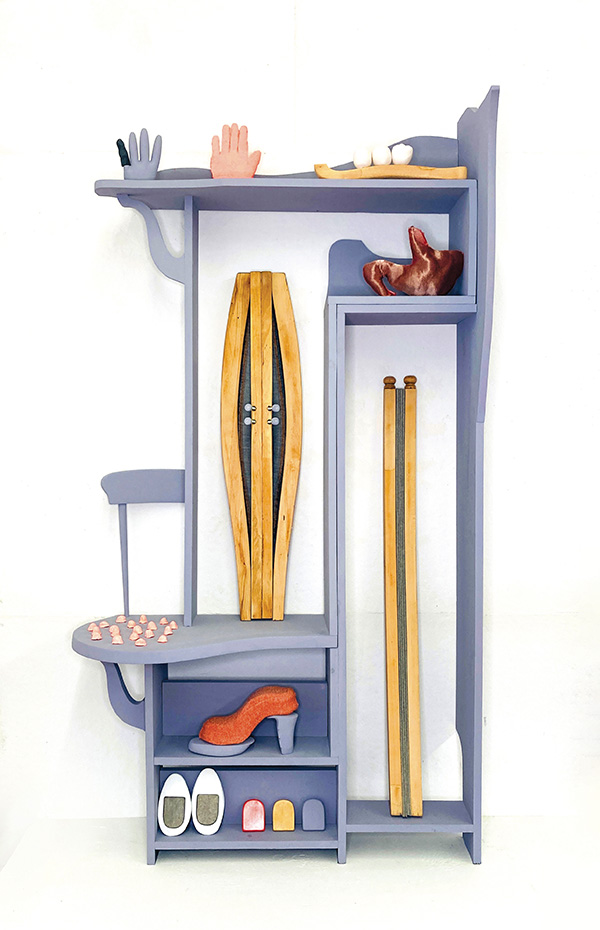
Lu Heintz, Habitus, 2021-ongoing, wood, plaster, steel, fabric, plastic, paper pulp, and found objects, dimensions variable. Photo: Lu Heintz. Overlap is a dynamic new gallery located just outside downtown Newport in a refurbished glass shop. Co-directed by artists Susan Matthews and Alicia Renadette, Overlap is committed to showcasing work that highlights rigor in craft, creating a space for underrepresented art that features textiles, installations, and other material investigations often spilling off the wall. Their upcoming exhibition Dreams of a Common Language promises a unique interpretation of fiber arts which will continue to push the gallery into the forefront of Rhode Island’s art scene.
The exhibition features three Rhode Island-based artists and educators. Lu Heintz, Elizabeth Duffy, and Anna McNeary are united in their explorations of
gender, craft, and identity through textiles, installation, and performance. Dreams of a Common Language takes its name from an Adrienne Rich collection of poetry from which the three artists have taken to sending excerpts to each other as a grounding, meditative practice.Meticulous in craft, Duffy studies the cyclical nature of clothing through her current project Wearing. This series involves her carefully unwinding braided scrap rugs, ironing and patchworking tattered scraps, and metamorphosing them into garments and wall hangings. The works often remain tethered to the placental mass of the original rug, disrupting their use as either clothing or rug.
Tethering and transformation are reflected in McNeary’s performative works. She explores the vulnerability of social intimacy through modular clothing that links together participants. Additionally, McNeary utilizes screen printed textiles featuring repeated words such as “certainty,” “now,” and “never” to create quilt style wall hangings where words become abstracted. Like the connective clothing, the words undulate in and out of recognition and blur their function as statement or pattern.
Heintz continues the themes of transfiguration in her installation Habitus, a whimsical display of furniture and household objects. Closer inspection will reveal an organ-like plushie slouching in the chair, a red stocking dangling seductively off of a coat stand turned foot, and other bodily mirages that hint these objects may be anthropomorphizing.
The works of Duffy, McNeary, and Heintz are playful, transformative, and reject the language of object, artwork, and entity.
— Eleanor Q. C. Olson
- As the World Burns: Queer Photography and Nightlife in Boston
Tufts University Art Gallery, Boston, MA • artgalleries.tufts.edu • Through April 21, 2024
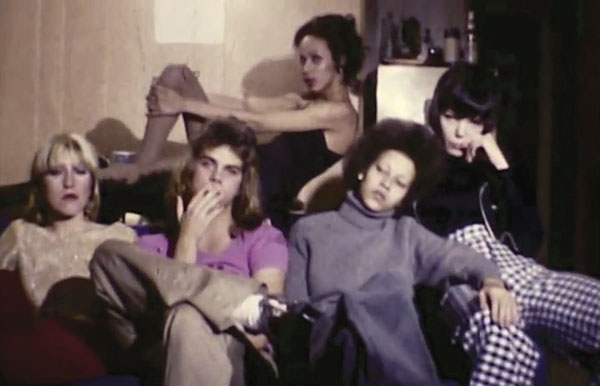
Mark Winer, As the World Burns, 1973, digitized super 8 film, 18:00 min. Courtesy of the artist. Presented simultaneously with Christian Walker: The Profane and the Poignant, As the World Burns: Queer Photography and Nightlife in Boston takes a deep dive into the photography of Boston’s queer scene from 1974 to 1984, corresponding with Walker’s time in the city. Defying genres, the exhibition unites fine art, instructional, vernacular, and documentary photography with experimental video and photographically derived textiles. Curated by Jackson Davidow, Ph.D., in collaboration with the TUAG curator, Laurel V. McLaughlin, the exhibition highlights a new presentation of photographically generated works formed from LGBTQ+ histories contextualized within Boston and its changing cityscape.
Upon entering, we follow Walker’s series The Theatre Project, a line of analog black and white prints diving into the cruising culture of the Pilgrim Theatre, the images reveal shifting scenes of lone figures dimly glimpsed and couples kissing. These photos set the exhibition tone–contemplative, passionate, considerate, and frank–often located on the streets of the Combat Zone, in nightclubs, and glancing in on intimate scenes.
On one wall, photographs highlight a single fashion show at Spit, a former nightclub on Lansdowne Street, where Gail Thacker, one of the performers, captured the excitement of readying for the night. The only depiction of the fashion show itself is Philip Phlash’s Mark Morrisroe, Pat Hearn and Friends, capturing the performers giddy on stage.
Images surround Mark Winer’s Super 8 film, after which the exhibition is named, As the World Burns (1973)–dreamlike and almost erotic, Winer envisions Bobby Busnach’s life as a hustler and others pictured throughout the exhibition. Haunting and hypnotizing, it is hard to look away, as music entices viewers into scenes of friendship intermingled with masturbation and sexually explicit flirtations.
Illuminating Boston’s unseen queer histories, As the World Burns expands the canon of the Boston School, first coined by Nan Goldin and solidified by Lia Gangitano and Milan Kalinovska’s exhibition The Boston School. As the World Burns expands this canon to include many previously unconsidered artists. Focusing on a single decade and inviting a new perspective on community, passion, and intimacy, Davidow unearths the history of LGBTQ+ artists in Boston.
— Abbi Kenny
- Fluid Matters, Grounded Bodies: Decolonizing Ecological Encounters
Gallery 360, Northeastern University, Boston, MA • camd.northeastern.edu/cfa/center-for-the-arts-exhibitions/ • Through April 6, 2024

Farah Al Qasimi, Um Al Naar (Mother of Fire), 2019. Digital video, 42 minutes and 7 seconds. Courtesy of the artist. Gallery 360, nestled into Northeastern University’s campus, presents this stand-out exhibition featuring artists Farah Al Qasimi, Beatriz Cortez, micha cárdenas, Tessa Grundon, Allison Janae Hamilton, Joiri Minaya, Ada M. Patterson, Wendy Red Star, Himali Singh Soin, Annie Sprinkle, and Beth Stephens. Originally presented at NYU’s Gallatin Galleries in July 2022, Northeastern’s team worked with the curators to re-envision the exhibition for Northeastern and Boston. The show spans two venues, Gallery 360 and Northeastern Crossing, a public-facing community-oriented initiative providing a space for students and residents. Aimed at deconstructing hierarchical and colonial narratives around climate change, this exhibition positions itself as a place for self-discovery and reflection on the current climate crisis.
Upon entering the corridor-like gallery sided by one long glass wall offering a view to passersby, we encounter Wendy Red Star’s collages from the series A Float for the Future (2021). Brightly colored fabric and images reimagine the Crow Fair Parade with an eye toward future potential. Arranged into four sections, the exhibition begins here with Counter-Histories and Mythologies of Place, then moves through Bodily Presence and Absence, Kinship as Remediation, and Beyond the Coloniality of Place.
One highlight is Farah Al Qasimi’s Um Al Naar (Mother of Fire). A 42-minute and 7-second video in a documentary-style reality TV format presenting a Jinn from Ras Al Khaimah, UAE. Through a combination of found footage and interviews in this strange and captivating video Al Qasimi explores local history, colonial history, myth, and issues of identity.
Throughout the exhibition, time becomes layered and compressed. Works like micha cárdenas’s Sin Sol/No Sun (2018) place the player in an augmented reality video game set in the year 2068, and Joiri Minaya’s collages combine historical and contemporary images of Dominican and Caribbean women and landscapes illuminating the legacy of colonialism.
In addition to community engagement spearheaded by Northeastern Crossing, an exhibition catalog will be available in early 2024. To be located in the gallery, the catalog will include three interviews with artists Cortez, Patterson, and Soin, providing visitors with an expanded view into the artworks and artist’s practices. This exhibition is an exceptional reason to visit and explore Northeastern’s campus.
— Abbi Kenny
- Radical Pots & Cooperative Hands: Katherine Choy and Clay Art Center
Greenwich Historical Society, Cos Cob, CT • greenwichhistory.org • Through February 4, 2024
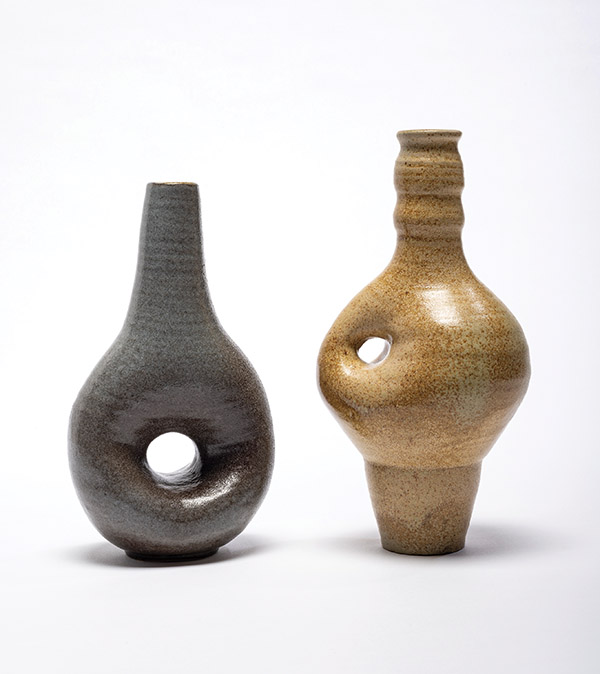
Katherine Choy, ca. 1957, Pair of Bottles, left to right: Bottle with Donut Shape, stoneware, 9.5″; Long-Necked Footed Bottle with Thumb Hole, stoneware, 11″. Clay Art Center Collection. Photo: Paul Mutino. Radical Pots & Cooperative Hands: Katherine Choy and Clay Art Center is an exhibition that showcases the work of an incredible artist, as well as the stalwart community that she helped build.
Katherine Choy first came to America from China to attend college in 1946. By 1952, she had obtained bachelor’s and master’s degrees and became the head of the ceramics department at the Newcomb College at Tulane University. In 1957, she came into contact with Japanese-American potter Henry Okamoto, and soon after they founded Clay Art Center in Port Chester, NY. Tragically, Choy died of pneumonia at age thirty only one year later in 1958. Despite this hardship, Okamoto, the Port Chester community, and surrounding areas fought to keep Clay Art Center alive, and the nonprofit is a staple of the local arts community to this day.
Okamoto not only saved Clay Art Center after Choy’s untimely passing, he and the Clay Art Center staff also saved her work, notes, and her correspondence with Okamoto when the two were making plans for the Center. Many of these historical objects, including business documents, photographs and personal letters are on display alongside ceramic works by both Choy and Okamoto.
Choy’s ceramics are elegant, with great care shown towards delicate forms and complex glazing techniques, which were some of her specialties. Samples of Choy’s notes on and experiments with glazes are also on display. Around the time of her death, Choy was beginning to work on a larger scale as her pieces moved away from the functional and towards the purely aesthetic and sculptural. “They show that she’s trying to play around with surface and texture and thinking about basically making art that comments on its form and making,” remarked curator Maggie Dimock. Choy was talented and extremely prolific, as well. In the year she lived and worked in Port Chester alone, she created more than 200 pieces.
Greenwich Historical Society, with the help of Clay Art Center and other community partners, honors the legacy of a brilliant potter lost before her time and those who have kept that legacy alive for more than sixty years.
— Autumn Duke
- Totally Tubular
Tubular Times: Camp, Horror, and Music Television: Video Art 1981-1993 | Real Art Ways (Hartford, CT) | Through January 14, 2024

Possibly in MIchigan, 1983, Cecelia Condit, Courtesy Electronic Arts Intermix (EAI), New York. The parodic title of this delightfully indulgent and musically cantankerous group exhibition of new media art from the 80s and early 90s says it all—grab a pair of headphones, leave 2024 behind and dive in. Yet watchers beware: identity politics, capitalist ruination, mental illness, public trust, the cult of celebrity, natural disaster and feminist critique are just some of the themes that weave throughout the 300 minutes of footage, and eerily boomerang us back into the moment we’re living in.
The same could be said for the joyfully tubular experimentation in early video as a medium. Sampling, light filters, sound distortion, speed ramping, frame shots, scrolling captions and supranational live broadcast are just some of the special effects that recall our everyday contributions to social media posting. The narrators, much like today’s TikTok and IG users, are predominantly the artists themselves, self-cast as influencers, icons, talking heads, entertainers, documentarians and instigators.
The premise of Tubular Times is loose and wily. This is not a show that purports to comprehensively or conclusively represent a twelve-year window of video art. Really the commonality is a shared reverence and skepticism for television’s ever-growing presence within the American household. Given this curatorial freedom, many of the works have never been shown side by side before.
One surprising constellation features videos with strictly musical scripts. A Surrealist-inspired video by Cecilia Condit, which opens in a mall, tells the story of a woman with a chronically flawed love life. The original lyrics include the story of a poodle exploding in a microwave oven. Nearby, a rock opera by Michael Smith casts a contemporary light on the history of Manifest Destiny. Dressed as a cowboy mayor, Smith pitches real estate plans to win the town’s vote. Two TVs down, Dara Birnbaum manufactures a music video for Jimi Hendrix’s Fire!, which Hendrix never produced because the release predated MTV and the birth of the music video genre by fourteen years. The simple video features scenes from a fast food drive through, and cuts to a girl on a roofdeck drinking a beer from a glass.
The system articulated in Birnbaum’s film delivers the exhibition’s takeaway. We are on display. We put ourselves on display. We consume. We get consumed. As we cozy into the nostalgic moments of this show, this doesn’t mean we can’t long for simpler pre-internet times, when we crafted home movies in our basements with friends, or just knew less about breaking news around the world. It reminds us that we’re still deeply invested in the act of making images of ourselves to figure out just who we are, and where we’re located, in this given system, or the next to come.
-Sarah Fritchey
- Distant Visions: John Woolsey
Zillman Art Museum/University of Maine, Bangor, ME • zam.umaine.edu • Through December 30, 2023

Lazy S #1 (Mirrored), 2021, restructured woodcut, 25½ x 45″. Courtesy of the artist. “My work explores the concepts of time, breakdown, reordering and renewal in the environment,” writes John Woolsey in the catalogue for his solo show at the Zillman. The artist, who travels between Philadelphia and the Maine coast, offers nearly seventy pieces in oil, watercolor, acrylic, gouache, and woodcut—sometimes in layered and/or collaged combinations—that continue his dialogue with elements of the natural world, be it a forest floor, an estuary or a coral reef.
Woolsey traces this work, dating from 2018 to 2023, to drawings he made of ancient trees in temple gardens in Japan in 2010, in particular “root-scapes” formed by roots winding through moss. He transformed these and other sketches into sometimes dense compositions that might be called lyric abstractions, albeit with suggestions of the original subjects: leaves, plants, clouds, islands.
The complexity of pieces like the watercolors on woodcut Forest Floor #1 and Tondo #17 (Tide Pool #2) bring to mind the work of Alan Gussow and Emily Brown who found inspiration in similar subjects (including compost piles). Six vertical collages, a couple of them with jagged edges, underscore Woolsey’s sumptuous designs, edging into the decorative in the case of Spring Garden and Ripples.
Moving beyond the formal rectangle of earlier landscapes Woolsey explores a variety of engaging shapes, including fans, tondos, saw blades, a wave, and one he calls a “lazy S.” Arranged in groups on the museum walls, they form striking configurations.
Among the most recent work in the show is Reef, a stunning large (48 by 72 inches) oil. All manner of coral—brain, fan, finger—form a glowing underwater tapestry, unreal in its vivid coloration. Another 2023 oil, Delta, conjures the twisting arteries of water as seen perhaps from a satellite.
Woolsey is also showing at the Caldbeck Gallery in Rockland. John Woolsey: Time and Transformation (through November 4) features similar work, plus a group of earlier, more realistic landscapes, including some lovely pastels and gouaches of blueberry barrens, coastal ledges, and glacial erratics. Together, these shows provide exciting evidence of Woolsey’s ever-evolving vision.
— Carl Little
- The Brush and the Pixel
Fine Art Gallery, Colby-Sawyer College, New London, NH • colby-sawyer.edu/gallery • Through December 7, 2023
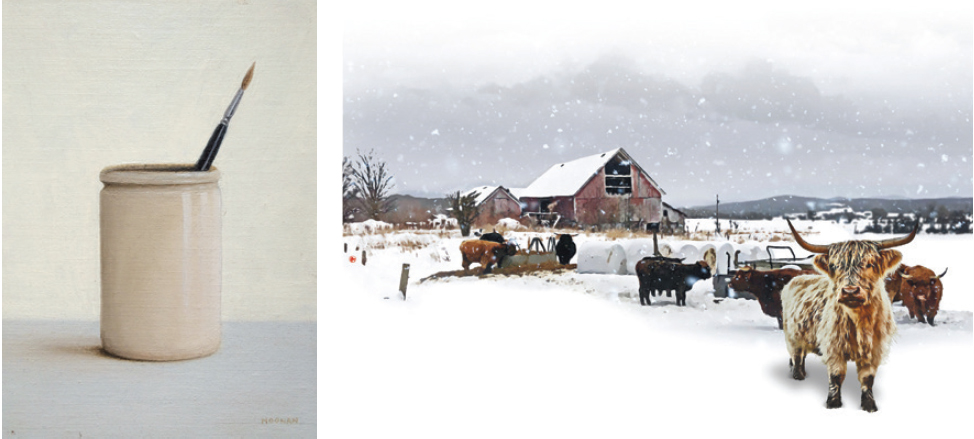
Above, from left: Peter Noonan, Brush in Jar, 2008, oil on linen on panel, 6 x 8″. Jack Tremblay, Winter Silence, 2023, digital composite, 40 x 27″. Courtesy of the artists. Depending where you stand in Colby-Sawyer College’s art gallery, there is an expansive mountain view competing with the artwork on the walls. The college sits on a hilltop in the Dartmouth-Lake Sunapee region, halfway between the state capital of Concord and the Ivy League town of Hanover—prime leaf-peeping country. The gallery is located in the nearly-new Davidow Center for Art and Design, a modern yet barn-like structure that complements the small campus’ historical architecture.
The Brush and the Pixel is the gallery’s latest exhibition, showcasing the work of two alumni: Peter Noonan and Jack Tremblay. Graduating one year apart from the college’s fine arts program, they have taken their art careers in very different directions.
Noonan is an illustrator, fine artist, and cartoonist who lives in Manchester, NH. His work on display includes editorial cartoons, caricatures, portraits, still-life and abstract paintings, and illustrations from his children’s book, The Bike Bus. A subtle still life (Brush in Jar, oil on linen on panel) is arresting in its Shaker-like simplicity, depicting a pale ceramic jar holding a single paintbrush. Noonan’s other paintings include a study for a water color portrait of the late Robert Stark that hangs in the New Hampshire State House. Also included are cartoons from the “Drawn and Quartered” series, inspired by political campaigns. “There’s never a shortage of material during the New Hampshire Primary,” the artist says.
Tremblay, an art director and corporate designer in northern Vermont, uses digital techniques. His works include abstract digital collages created with found, archival, and Creative Commons images. In some compositions, design, photography, and cultural appreciation coexist in one form. The exhibit includes Winter Silence, a snowy farm-scape complete with shaggy cattle. The scene is composed of ten separate images, then finished with hand details and mechanical color treatment features in Photoshop. The bull’s furry detail is done with a stylus and digital drawing pad. Tremblay (who describes his work as “unusual art for thoughtful people”), hopes his images “invite a laugh, a thoughtful pause, or a pondering stare.”
Colby-Sawyer College’s gallery is open when the school is in session. It is closed over the holiday break, re-opening in January with an exhibition of pieces selected from the permanent collection.
— Laurie D. Morrissey
- CONFLUX: LLOYD MARTIN + STEPHEN NICCOLLS
A guest curatorship by Jessica Hagen
Dryden Gallery/Providence Picture Frame, North Providence, RI • jessicahagen.com • Through December 2, 2023
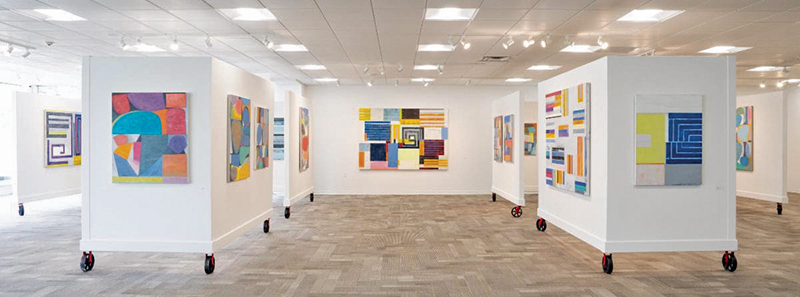
Installation view Conflux: Lloyd Martin + Stephen Niccolls. Photo: Dryden Gallery. The Dryden Gallery’s expansive exhibition space is the ideal venue for CONFLUX: LLOYD MARTIN + STEPHEN NICCOLLS, two accomplished, mid-career American artists. The exhibit includes forty-plus paintings, many large scale, and is presented by guest curator Jessica Hagen of Jessica Hagen Fine Art + Design of Newport, RI.
Hagen chose the name of the exhibition, CONFLUX, as it means a coming together, a confluence of Martin’s and Niccolls’ work. “To my eye, their paintings are a natural pairing,” says Hagen. “Both artists are highly skilled colorists creating compelling non-representational compositions. Martin’s work employs the use of straight lines to wrangle, define and convey areas of color, while Niccolls makes use of curvilinear shapes to do the same. The juxtaposition of these two stylistic approaches is exciting, uplifting, and energizing for the viewer.”
Martin is a Providence native and a graduate of the Rhode Island School of Design. Internationally recognized, his abstract work is often compared to music. Art critic John Goodman wrote that Martin’s paintings “achieve a Mondrianesque climax of rhythm.” The viewer perceives linear movement throughout his paintings and is expertly guided by Martin’s vibrant color juxtapositions. Furthermore, Martin references architecture in his paintings, though clearly abstract, that gives his work a sense of gravity and weight.
Niccolls hails from the Hudson Valley and received a BFA from the School of Fine Arts, Boston and an MFA from UMass Amherst. “Every sensation I’ve known can potentially find its way into my paintings,” says Niccolls, whose work arises from a fascination with structure. “Each painting establishes its own unique context, or world,” says Niccolls. “It may have elements that evoke still-life, landscape, or portrait painting, or some combination of any of these, or perhaps something else entirely.” Niccolls has exhibited extensively in museums and galleries throughout New York state and the northeast and is the recipient of the Phelan Award, the Purchase Award from the Samuel Dorsky Museum of Art, and the Albany Mayor’s Prize.
— Emily Randolph
- Gary Koeppel: Skyline
Inner Space Fine Arts, North Reading, MA • innerspace-fineart.com • November 4-December 16, 2023

Above, from left: Gary Koeppel, January 14, 2022, 5:47 p.m. and December 30, 2022, 5:46 p.m. oil on board, 12 x 26″. Courtesy of the artist. Inner Space Fine Arts opened its doors just a few weeks before the COVID-19 shutdown, in March 2020. While owner and director Allyson Paladino was planning for an uncertain future, artist Gary Koeppel was sitting in his Roslindale, MA, studio, gazing out his window at the everchanging Boston skyline. Although they didn’t know it yet, their paths would cross when the now-bustling Inner Space gallery agreed to show Koeppel’s work in Skyline this fall.
Koeppel was struck not just by the beauty of the skyline, but by the feelings it elicited. “There were so few people out on the roads at that time,” he shared. “There was that sense of isolation that I think we all felt, and I had a strong sense of that even looking out at this skyline.” Seeing Koeppel’s series does indeed conjure those feelings of distance and isolation that came with the 2020 shutdown. And yet, there is also a deep appreciation and love for the city that is made clear in the care he shows bringing it to life.
No two pieces in the series are the same, although each of them depicts the immutable shape of the city set against the innate changes of the natural sky. Two paintings based on photographs taken at almost exactly the same time, nearly a year apart, carry entirely different tones and colors. January 14, 2022, 5:47 p.m. is drenched in the familiar pink-and-orange light of a setting sun. A few colorful lights can be seen in the foreground where shadow has cast that part of town in early night. December 30, 2022, 5:46 p.m. is all blue and gray, except for the shining golds of the setting sun reflected against the skyscrapers.
Koeppel has been a working artist for more than forty years. He received his bachelor’s degree from the Maryland Institute College of Art, where he discovered a love for oil and plein air painting. He has been exhibited throughout New England and New York and has pieces in collections in the U.S. and Europe. “He has a painterly approach to the realism of a scene, and he gives it a sense of heart and spirit,” said Paladino.
— Autumn Duke
- Northwoods: Absence and Presence. The Art of Alan Bray and Poetry of Wesley McNair
Monson Arts Gallery, Monson, ME • monsonarts.org • Through October 29, 2023
In a 2009 talk connecting Edward Hopper’s art to literature, Harvard professor Peter Sacks offered various “analogues and oblique illuminations,” parallel aesthetics between his work and the verse of various poets, including Elizabeth Bishop and Robert Frost. This exhibition of paintings by Alan Bray and poems by Wesley McNair underscores that concept: no ekphrastic connection here, just kindred spirits.
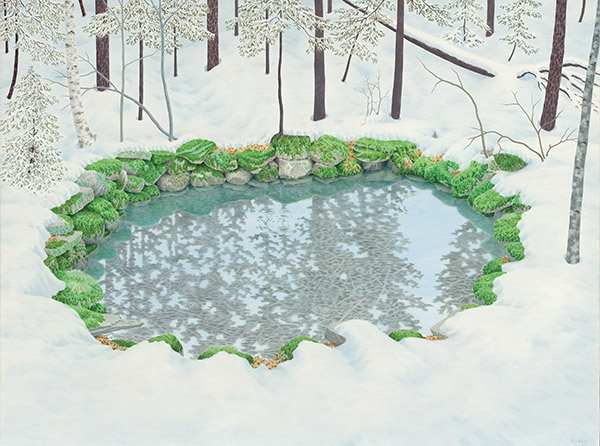
Alan Bray, Cheese Factory Spring, 2007, casein on panel, 24 x 18″. Courtesy of the artist. By way of eighteen caseins, an oil, a giclée print and a drawing, and nineteen poems (from Late Wonders: New and Selected Poems, 2022), painter and poet present a Maine that lies not off the grid, but pretty close. And they know the territory well: Bray has lived in Sangerville for much of his life while McNair is a longtime resident of Mercer, both hamlets in the state’s hinterlands.
The pairings are inspired. McNair’s “In Praise of a Tree,” a tribute to an ancient white pine that has carried “cargoes of squirrels and song birds,” accompanies Bray’s Uprooted, 1994, a marvelously gnarly and surreal arboreal creation rimed with ice and snow.
Poet and artist make beauty out of the overlooked or unsung. Who could imagine a poem about telephone poles “balancing cables on their shoulders” might be transcendent in its vision? Bray’s Cheese Factory Spring, 2007, depicts a lost woodland watering hole; critic Edgar Allen Beem once called it “the apotheosis” of his “gnostic talent for evoking the hidden narrative of landscapes.”
In a statement for the show, McNair notes that his Maine “features people” while Bray’s “is largely without them.” That said, the individuals that appear in the poem “Seeing Mercer, Maine,” including “the old/man from the coast who built/the lobster shack/in a hayfield,” are kin to the folk who cut the slate that appears in Bray’s Hebron Quarry, 1980.
“Reading Wes’s poems or looking at Alan’s art,” writes curator Stuart Kestenbaum in the exhibition catalogue, “it’s clear…they have taken the time to examine the power of place—how we shape the land and it shapes us.” They also know how to shape our vision of a world through powerful poems and paintings.
— Carl Little
- Taking Place
HallSpace, Dorchester, MA • hallspace.org • Through October 21, 2023
Ellen Shattuck Pierce is a journalistic narrator in art. Her keen observations of her feelings and responses during the COVID pandemic and her experience as a public school teacher, mother, and artist inform the eighteen prints which comprise the Covid Chronicles which premier in the HallSpace exhibit. The works are a result of Shattuck Pierce’s 2022 Massachusetts Cultural Council Artist Fellowship.
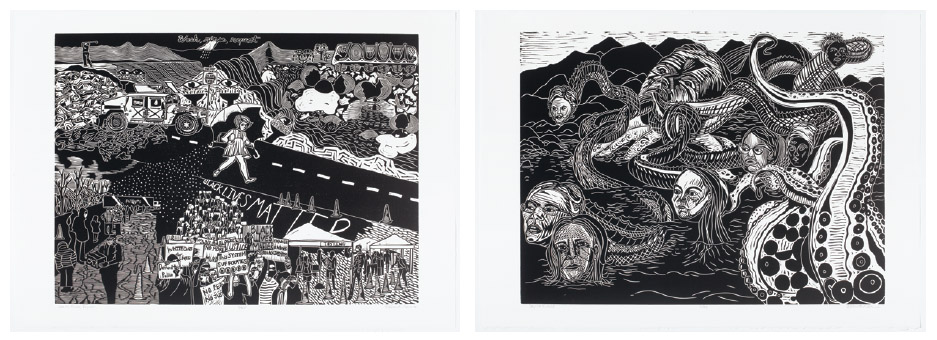
From left: Wash, Rinse, Repeat, 2020, relief cut, 18 x 24″. Circling Around, 2021, relief cut 18 x 24″. Photos: Will Howcroft. The tethering to the world wider than the personal is present throughout the series. In 4/13/20, a solitary woman staring out of her window is attached to a rope which wanders outside forming a heart that lassos universal symbols depicting populations and activities most threatened by COVID.
Replete with allegory, in Wash, Rinse, Repeat, an isolated child walks a proverbial “highway,” surrounded by scenes of people lined up for vaccines, for food, for Black Lives Matter protests. It is a stark presentation of what people could no longer pretend “not to see.”
Shattuck Pierce’s densely packed linotypes in relentless black and white emphasize the reduced quality of life visited upon all during the pandemic. In Reopening, which refers to the summer of hope in 2020, there is a sense of light permeating the usually dark palette. Winter Peril, which chronologically follows it, shows the return to isolation. Its figures appear mummified, wrapped once again by their constraints.
Circling Around shows off Shattuck Pierce’s masterful skills in creating motion through mark making. The endless spirals are almost dizzying as she references the vortex of emotion we felt as a nation on January 6, 2021, the day of the insurrection, with the Capitol encircled for weeks afterwards. Accompanying personal circles of solitary activities continued to mark every person’s day, measured by the rotation of a clock’s hands.
In an article she wrote, Bearing Witness, Pierce notes “All this is happening, all at the same time, and all of it is true.” The pandemic created a magnifying glass illuminating this ever-present reality. The series Covid Chronicles remains as a testament to a key moment in human history and a reminder of some of the lessons that we “perhaps” have learned.
— B. Amore
- Mickalene Thomas / Portrait of an Unlikely Space
Yale University Art Gallery, New Haven, CT • artgallery.yale.edu • Through January 7, 2024
This intriguing exhibition of small-scale portraits, from miniatures and daguerreotypes to silhouettes on paper and engravings in books of African-American women, men, and children from the pre-Emancipation era, was inspired by a palm-sized watercolor painting on ivory from the 1830s gifted in 2016 to the Yale University Art Gallery.
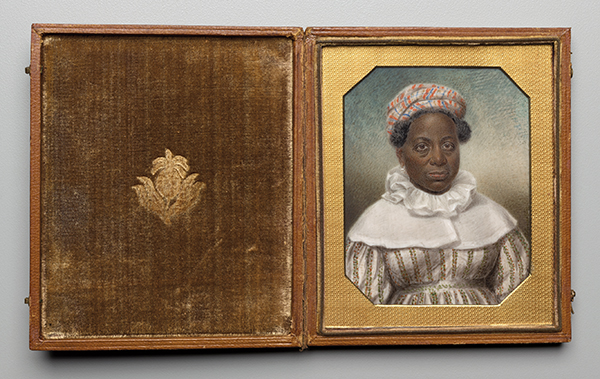
Sarah Goodridge, Rose Prentice (1771–1852), ca. 1837–38. Watercolor on ivory. Yale University Art Gallery, Partial gift of Caroline A. Phillips and purchased with the John Hill Morgan, b.a. 1893, ll.b. 1896, hon. 1929, Fund. The miniature depicts a formerly enslaved woman, Rose Prentice (1771–1852), painted by Sarah Goodridge (1788–1853), a largely self-taught artist whose miniatures, especially those painted on ivory, were sought-after and widely exhibited: Goodridge’s subjects included Daniel Webster and Gilbert Stuart. It is believed Prentice and Goodridge met when both were living in Boston.
“Prentice’s personal tribulations of enslavement, her decades-long labor as a domestic worker in white households, and the commission and ownership of her portrait by white patrons offer possible points of connection with the individuals pictured in the other historical objects on display,” according to Keely Orgeman, Yale’s associate curator of Modern and Contemporary Art and exhibition co-curator.
Portrait of an Unlikely Space is co-curated by internationally acclaimed artist/activist Mickalene Thomas (Yale M.F.A. 2002), the primary artistic contributor to this exhibition. Thomas is known for sumptuous paintings and photographic portraits of Black women as well as immersive, living-room style installations such as the one she is creating for Yale, which aims for the aura of a pre-Civil War interior. Complementary artworks, many incorporating the work of early-career artists of color, include sculpture, video and Thomas’ Polaroid photographs. “Our exhibition is a way of deepening the sense of interconnectedness among the stories of those who are included, whether as subjects or artists,” adds Orgeman.
“The meanings of Prentice’s portrait unfold the longer you sit with it, and that’s the kind of engagement I hope to facilitate with the other works, too, by enveloping them within transformed galleries where visitors will want to linger. I created my previous domestic settings primarily for fellow Black women—my ‘muses’—to spend time and have new experiences in familiar surroundings, perhaps resembling their mothers’ or grandmothers’ living rooms,” writes Thomas in the exhibition catalogue. “The sitters are my muses here. I dedicate this space to them.”
— Susan Rand Brown
- Alison Hildreth: Fifty Years; Late Summer: Alison Hildreth Prints and Drawings; Darkness Visible
Speedwell Projects, Portland, ME, speedwellprojects.com, Through December 22, 2023 • New Era Gallery, Vinalhaven, ME, neweragallery.com, Through October 11, 2023 • Center for Maine Contemporary Art, Rockland, ME, cmcanow.org, September 30, 2023–January 7, 2024
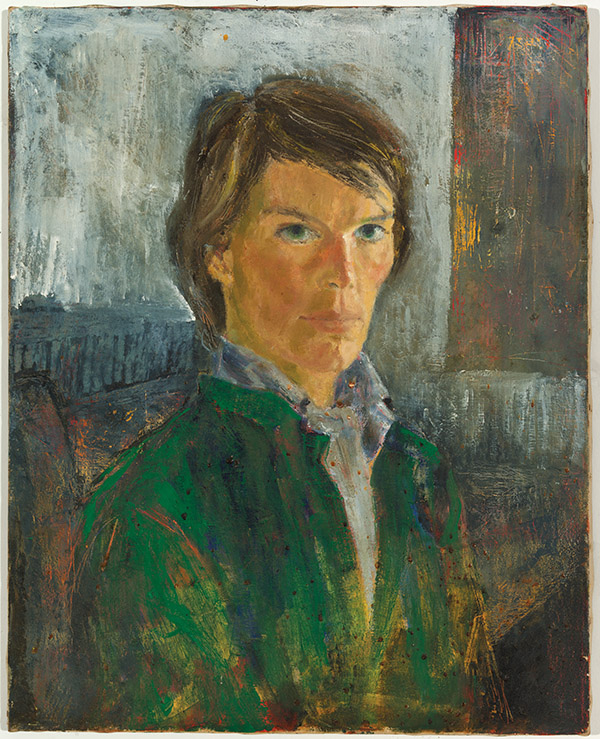
Self Portrait I, 1976, oil on canvas, 16 x 16″. Courtesy of the artist. Since she started showing her work in the 1970s, Alison Hildreth has never ceased to add admirers to her ever-compelling work—and to play a key role in Maine’s art scene as artist and advocate. Practicing in a range of mediums, including oil, ink, and various printmaking methods, Hildreth creates a universe where bats fill the evening sky, maps lead to new ancient lands, and beekeepers enact mysteries.
This fall, all the stops are being pulled out to celebrate Hildreth and her contributions to the art world. Each of three Maine venues is showing different aspects of her oeuvre with some overlap.
Speedwell Projects in Portland, where the artist maintains a space in the Bakery Studios, offers a mini-retrospective, including two self-portraits from 1976. In one, the painter looks squarely at us with a serious expression; in the other, more abstract rendering, she stands at her easel painting. These paintings and some others in the show have never been exhibited before.
Another painting in the Speedwell show, Beekeepers, features a fantastic vision of what might be a cave where Brueghel-like beehives frame a puppet show run by eleven disembodied blue hands. Black shapes are suspended by thin strips of paper with words on them. The whole scene has a Dante-esque feel to it.
New Era Gallery on Vinalhaven, an island Hildreth has frequented for decades, will present a group of twenty or so prints and drawings.
Several pieces feature one of her signature subjects, the bat. In her hands, this nocturnal mammal emerges in mid-flight, its wings broad and arched in air—the essence of motion.Other standouts in the New Era show are a lovely rendering of a dogwood blossom and two of Hildreth’s map works. Red Fort is an arrangement of coordinates and twisting arrowed lines superimposed on imaginary terrain while East features a molecular diagram set atop what look like plans for a fortress town and elaborate landscaped domains from an earlier century.
At the Center for Maine Contemporary Art, Hildreth is showing two bodies of work from recent, ongoing series. One of them features large aerial views of the earth painted on gampi paper made from the inner bark of a Japanese shrub. Hildreth studied landscape architecture in college and has never escaped, she writes in a statement for the show, “the idea of some form of map making.”
The other series reflects Hildreth’s fascination with the images arriving from the James Webb space telescope, photographs, she writes, of a “universe that we are a part of, a small blue planet in a vast and gorgeous and dangerous place.” Her oil paintings conjure the tumultuous edges of outer space and reflect her interest in “the complexity of life on earth and the relationships we have with the ecology of the planet.”
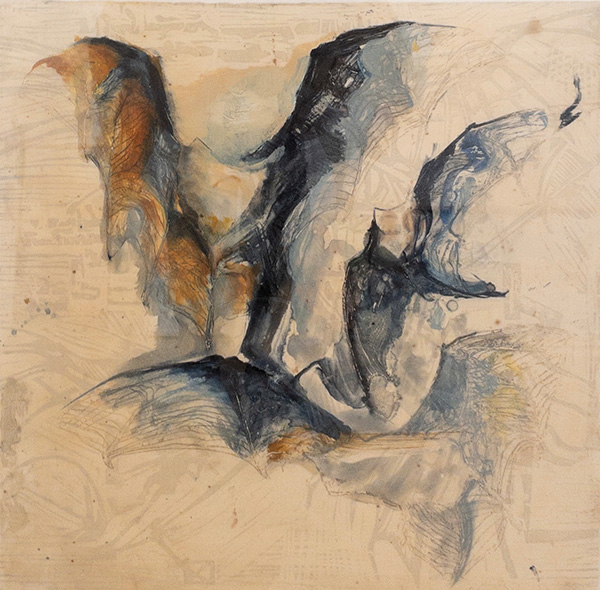
Flight #9, 2001, monoprint, 16 x 16″. Courtesy of New Era Gallery. Speedwell has recruited photographer and writer Smith Galtney to produce a documentary about Hildreth that will be shown during the exhibition. Additional special events are planned for the Portland Museum of Art and the Portland Public Library where Hildreth’s large-scale installation The Feathered Hand is on permanent display.
Suspended in the atrium The Feathered Hand is comprised of glass and plastic puppets, lenses, metal wire, sand, insects, and carborundum. The piece, which Hildreth says was inspired by her long-term interest in puppets, takes its name from a poem by Polish poet Zbigniew Herbert, “Chosen by the Stars,” which ends with the lines, “When he [the poet] has fallen all the way / he kicks with his legs / hangs for a moment / waving his feathered hand.”
“We believe that Alison Hildreth is a national treasure,” reads the Speedwell press release. On the basis of these three shows, that estimation rings true.
— Carl Little
- Barkley L. Hendricks in New London
Lyman Allyn Art Museum, New London, CT • lymanallyn.org • Through September 3, 2023
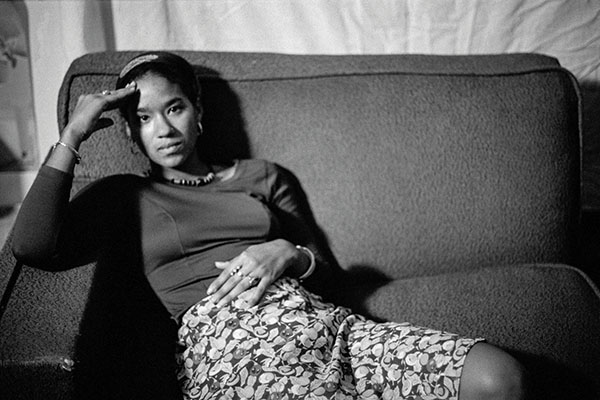
Barkley L. Hendricks, (American, 1945–2017), Untitled (Lynn Jenkins, New London), ca. 1975, gelatin silver print, 16 x 24″. © Barkley L. Hendricks. Courtesy of the Estate of Barkley L. Hendricks and Jack Shainman Gallery, New York. Friends, neighbors, former students, and colleagues turned out for the opening of the exhibition. For some, it was to pay homage to a masterful teacher who ruled with a demanding hand for close to 40 years at Connecticut College. For others, it was from remembering his large-scale hyper-realist portraits hanging in his downtown studio. Or perhaps they had encountered him on a city street with what he referred to as his “mechanical sketchbook.” Hendricks and his camera were out to catch snippets of life in this gritty city, and the exhibition is a marvelous starting point by which to consider the role of place, community, and teaching in Hendricks’ career.
Hendricks (1945–2017) died on the cusp of his ascendancy, and he perhaps would gasp at the news that one of his works just sold at auction for five million dollars or that an exhibition of his work will take center stage at Frick Madison in September. His photographs, which he often used as preparatory sketches, are highly valuable as well. Tanya Pohrt, who curated this thoughtful exhibition, selected 35 works by which to explore Hendricks’s regional story.
Hendricks studied at the Pennsylvania Academy of the Fine Arts and at Yale University before receiving his BA and MFA from Yale in 1972. The artist made life-size portraits of Black friends, relatives, and strangers—painting in the old master tradition, mindful that his interest in Black figuration in the 1960s and 1970s put him outside the mainstream of Black artists of that period. Floyd R. Thomas, Jr., suggested in an essay that Hendricks was the contemporary counterpart of “a West African griot who documents, preserves, and visually articulates the history of his people.”
And what an assortment—from young male fashion plates Hendricks encountered in Paris, to an ex-con he’d known when they were kids, stunning in a white-as-snow overcoat. His beautifully composed photographs, too, are full of life and character, whether it’s the saucy trio of sex workers, or the young boy at a local Fourth of July celebration whose smile lingers as a distillation of pure joy. Hendricks catches the patterns of a marching band’s shoes as well as the menacing visage of a white-robed KKK member at a rally in the early 1980s. Hendricks captured the good,
the bad, and the ugly, as well as the celebratory. — Kristin Nord - Eto Otitigbe, 2022 Saint-Gaudens Fellow
Saint-Gaudens National Historical Park, Cornish, NH • nps.gov • Through August 7, 2023
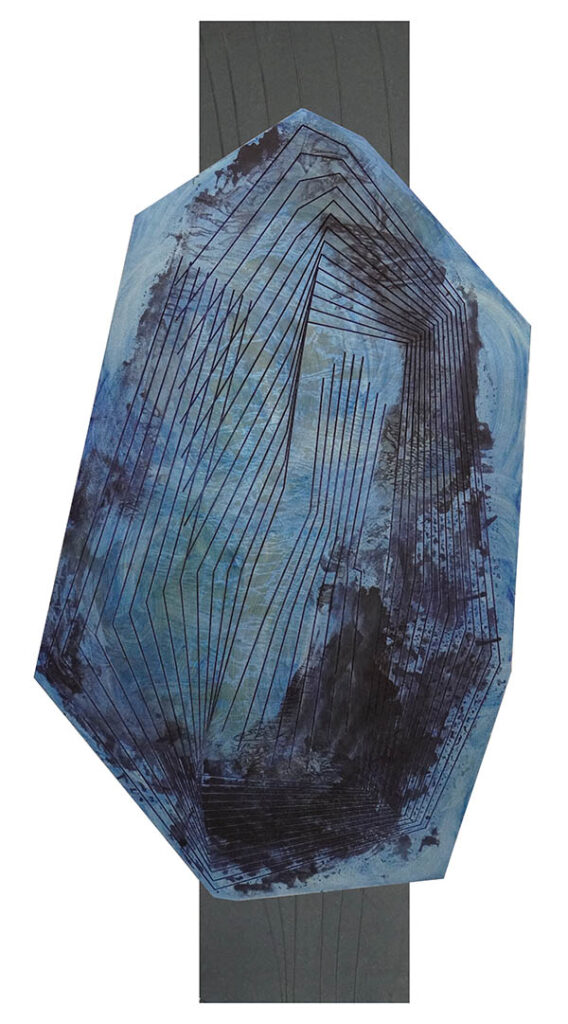
Blueprint for a Cosmic Mirror, Variant #1, 2023, aluminum plate, paint, Valchromat, 72 x 36 x 2″. Courtesy of the artist. The Saint-Gaudens Fellowship was launched in 1978 to provide financial support and exhibition opportunities to artists based primarily in the U.S. who are selected based on their exceptional exhibition record and the rigor of their work. The Fellowship is stewarded by the Saint-Gaudens Memorial, a non-profit organization housed on the grounds of Augustus Saint-Gaudens (1848–1907) home and studio in Cornish, NH. By promoting the work of contemporary American artists, the program links the legacy of Saint-Gaudens to current discourses in sculptural practice. The Fellowship culminates in an exhibition at the Saint-Gaudens Memorial each spring. Abra Ancliffe, exhibitions coordinator at Saint-Gaudens said, “Those of us at the Saint-Gaudens Memorial and the curatorial staff of the Saint-Gaudens National Historical Park support the artist’s vision and allow them to determine the scope of the exhibition.”
Fellow Eto Otitigbe’s exhibition opened this spring with a series of new works in Saint-Gaudens Picture Gallery. Otitigbe, a polymedia artist whose interdisciplinary practice includes sculpture, performance, installation, and public art, interrogates historical narratives and posits alternatives to conventional lines of thought through works that frequently combine sculpture, installation and new media.
Two new works, Okioso and Blueprint for a Cosmic Mirror, Variant #1, are installed in the East Room of the Picture Gallery, the primary exhibition space on the grounds. Okioso (2022) is a triptych on aluminum panels mounted to wood supports. The work, combining drawing, painting and assemblage techniques, features linear designs that resemble topographical diagrams. The designs are set against the luminous, variegated aluminum which give the piece an ethereal feeling.
In the West Room is Abandoned Orchestra (2021), a freestanding installation composed of hexagonal metal origami forms, organ pipes and a video projection with sound. This installation, in the center of the gallery, can be experienced in-the-round. Throughout his practice, Otitigbe extends the language of sculpture and imbues it with timely social commentary. His work is fresh and relevant to contemporary discourse, and activates the Beaux-Arts era venue in new and surprising ways.
As evidenced by this exhibition, the Saint-Gaudens Memorial Fellowship enriches the cultural landscape of New Hampshire’s Upper Valley by showcasing innovative contemporary artwork in this idyllic rural setting. — Eric Sutphin
- Nelson Stevens: Color Rapping
Springfield Museums, Springfield, MA • springfieldmuseums.org • Through September 3, 2023

Nelson Stevens (American, 1938–2022), Spirit Sister, 1971, acrylic on canvas. Collection of Christa & Michael Brinson. Photo: Greg Staley. Color Rapping, curated by Kiara Hill, celebrates Nelson Stevens’ fifty year career. The renowned artist, educator, and former Springfield resident influenced the art community as an early member of AfriCOBRA (the African Commune of Bad Relevant Artists). In his abstract expressionist works, he became a central figure in the Black Arts and Black Power movements while documenting the Black experience. In the early 1970s Stevens initiated a public art project in Springfield that made art accessible for those without access to museums. In over thirty murals throughout the city, Stevens’ promoted Black empowerment and gave way to a new movement which he dubbed Afro Kinetic Expressionism, a style that uses collage techniques to create images which give his works an almost three dimensional quality.
His figures, modeled after family and members of the community, replicate a stained glass that has been shattered, and then pieced back together. Enlisting geometric fragments, Stevens works breathe. His kaleidoscope compositions are represented in Heroic 1 and Spirit Sister. Over the years, Stevens immortalized figures such as Malcolm X, Stevie Wonder, Muhammad Ali, and Bob Marley. The artist, who passed in July 2022, used spray paint, colored pencils, airbrush techniques, and crayons to fashion this style he dubbed ‘color rapping.’
Stevens’ time in Springfield coincided with his tenure at the University of Massachusetts, Amherst, where he spent three decades teaching. One class was rooted in history and the other in figure drawing. Clyde Santan, a former student of Stevens, co-created The Wall of Black Music, a mural in Springfield. The piece, along with Tribute to Black Women, were recently recreated by Common Wealth Murals in honor of the late artist and were unveiled in October 2022.
In his early years, Stevens supported himself by painting murals in nightclubs in Utica, NY, where he would eat for free. Later, he taught at The Karamu House in Cleveland OH, the oldest Black producing theater in the country where his works are on permanent collection, as well as Kent State University, where the artist attended graduate school. Additional works are found in the permanent collections at The Smithsonian, Fisk University, The Chicago Institute of Art, and the Brooklyn Museum. — Jennifer Mancuso
- Nor’easter: Paintings by Terry Ekasala, Rick Harlow, and Craig Stockwell
The Bundy Modern, Waitsfield, VT • bundymodern.com • Through September 3, 2023
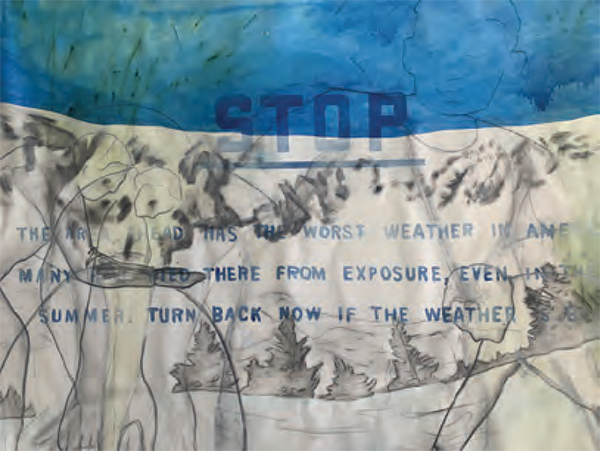
Craig Stockwell, Mt. Washington (memorial), 2022, oil on canvas and panels, 84 x 120″. Courtesy of the artist. Each year, locals and summer visitors flock to the Bundy Modern in Waitsfield, VT, greeted by art aficionados and owners/collectors Wendell and June Anderson. The Bundy Modern celebrates summer with a nod to an unforgettable yet classic New England experience—the nor’easter.
Nor’easter features work by established artists Terry Ekasala, Rick Harlow, and Craig Stockwell. Curator Richard Jacobs, who exhibited here in “Triad 2020,” he shares, “As artists, we relish any reason to stop in our tracks… and experience stillness. The reflections of light after a fresh snowfall create an optimal condition for alchemy in our studios to create deeper experiences with color, texture, and spatial illusion in our work.”
This collection of paintings offers an atmosphere of “otherness,” housed in the architectural gem of this International Movement gallery built on a sculpture garden. Energies of vibrating color, gesture and mapping of mountainous danger bring viewers to various points of emotion and contemplation.
Ekasala exhibits internationally as well as at the Hall Art Foundation and many other locations in Vermont. She is known for taking chances in her work—a master in layering semi-transparent abstract shapes in her compositions. Her gestures speak to the power of a nor’easter coupled with a magnificent palette.
Stockwell’s work in Nor’easter employs the perspective of mortality. Of his Mt. Washington (memorial) installation, he describes “The mountain is haunted…by all the deaths and being the one place in New England where the weather can suddenly force a climber to descend into real danger.” Merging drawing with painting, he reveals that other paintings in this installation explore “formal abstract relationships, mixing up formalist abstraction with dire narrative.”
Harlow has been working with native peoples in Columbia for the past 31 years—a strong influence in his work. On process, Harlow explains, “The paintings are created by splattering small drops of paint using a brush that I hit against a stick while painting on the floor.” A true colorist, his abstract works vibrate with an energy that envelops the viewer with the feeling of being in the eye of the storm. There is a sweet spot in looking at Harlow’s paintings where the color moves, shifting on the canvas—creating a hypnotic effect. — Kelly Holt
- Tony Sarg: Genius at Play
The Norman Rockwell Museum, Stockbridge MA • nrm.org • Through November 5, 2023
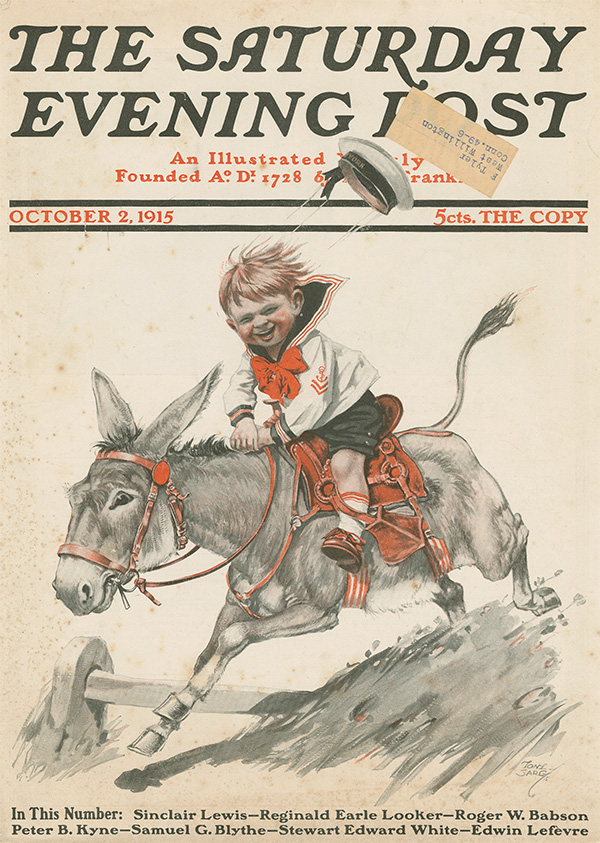
Riding the Donkey. Cover illustration for the Saturday Evening Post, October 2, 1915. Tear sheet. Collection of George Korn. Tony Sarg (1880–1942) was an advertising impresario who invested his artistic skills in a multitude of commercial enterprises during the 1920s and 30s. His illustrations ranked with those of Norman Rockwell. He was a leading graphic designer, a major promoter of puppet theater, and a pioneer in animation technology before the digital age.
Yet he is scarcely known today. “That’s because he over-extended his business ventures, fell into bankruptcy and died relatively young without an advocate to preserve his legacy,” explained the Rockwell’s Stephanie Haboush Plunkett, co-curator with Lenore D. Miller of the George Washington University Museum, of this colorful, richly diverse exhibition.
It’s aim, she said, “is to bring this important American artist and public figure to light for new generations.”
Born in Guatemala to a well-to-do German father and English mother, Sarg was schooled in Germany and moved to England in 1905 to pursue a career in illustration and study marionette theater. He married, fathered a daughter, and brought his family to the U.S. in 1915 after the start of WWI.
Settling in New York, Sarg became a U.S. citizen and amped up his already successful illustration and design work with marionette theater skills to bring animation to his commercial ventures, among them a national puppet touring company.
His signature achievement—the helium-filled, aerial floats of animals and pop culture figures created for the 1927 Macy’s Thanksgiving parade—still delight crowds. His top promotional stunt was to stage sea monster sightings in 1937 near his Nantucket summer home and shop to draw national press attention to the island. The “monster” was a former Macy’s float.
This exhibition, which moves to the Nantucket Historical Association next summer, captures the skill, energy and diversity of Sarg’s engaging accomplishments in three, tightly packed, deftly edited galleries. One introduces viewers to his early work; another focuses on his puppetry and book projects; a third looks at his large-scale achievements like the Macy’s parade and the sea monster hoax.
For an immigrant artist who helped define an era of American pop culture, the exhibition is a step toward renewed recognition.
— Charles Bonenti
- All Decked Out
Art for the Soul Gallery, Springfield, MA • artforthesoulgallery.com • June 10–September 10, 2023

Clockwise, from top left: Paul Goodnight, Untitled, 2022, painting on paper attached to board; Lourdes Morales, Untitled, 2023, acrylic on board; Madeline Williams, Life, 2023, acrylic on board; Ryan Murray, Jones, 2022, acrylic on board. All Decked Out celebrates skateboard decks reimagined into art. Art for the Soul Gallery championed the project in conjunction with its Transformational Arts and Culture Project. Honoring the legacy of the young skateboarder for which it is named, Gio’s Ollie Session is an endeavor funded by a Mass Development grant and a collaboration between the towns of Chicopee, Springfield, and Holyoke. The gateway city partnership promotes safety, advances inclusivity, and breaks down stigmas around skateboard culture.
In its second year, the grant was due in large part to the efforts of Art for the Soul Gallery owner, Rosemary Tracy Woods. Billy Myers, the Gallery’s artistic director, agrees. “We need to give one hundred percent credit to [Rosemary] Tracy… She wanted to include all of the cities surrounding Springfield.” In February 2022, Springfield’s Park Commission voted to build a new bike and skate park. Art for the Soul has hosted paint parties for young skateboarders along with safety gatherings.
The show will include roughly thirty artists. Anticipated submissions include John Longbow of the Choctaw and Chickasaw Nations who resides in New Mexico. Longbow designs guitars and is creating a stringed deck meant to be played. An artist himself, Myers is an art conservator specializing in period frames and altar pieces. His deck has been spliced in half to resemble an altar and mounted in a gold frame. “Some of these boards won’t even look like skateboards,” he says.
Artist Ryan Murray used the deck as a traditional canvas. “I’ve never worked on a skateboard before… I approached it the same way I would paint one of my vinyl records and just had fun with it, using a graffiti motif I was familiar with,” he says.
The exhibition coincides with Go Skate Date on June 21, 2023, and Theory Skate Shop, who provided the decks, plans to set up ramps and offer demonstrations.
“It’s time we changed people’s perceptions about skateboarding,” says Woods. After the exhibition, the works will be auctioned for a fundraiser. Other artists include: Paul Goodnight, Larry Poncho Brown, Dean Nimmer, Paul Midura, Nora Valdez, Marc Brown, Michael Tillyer, Anthony Melting Tallow, Peter Dellert, Scott Swan, and Richard Bulda.
— Jennifer Mancuso
- Nebizun: Water is Life
Bennington Museum, Bennington, VT • benningtonmuseum.org • Through July 16, 2023
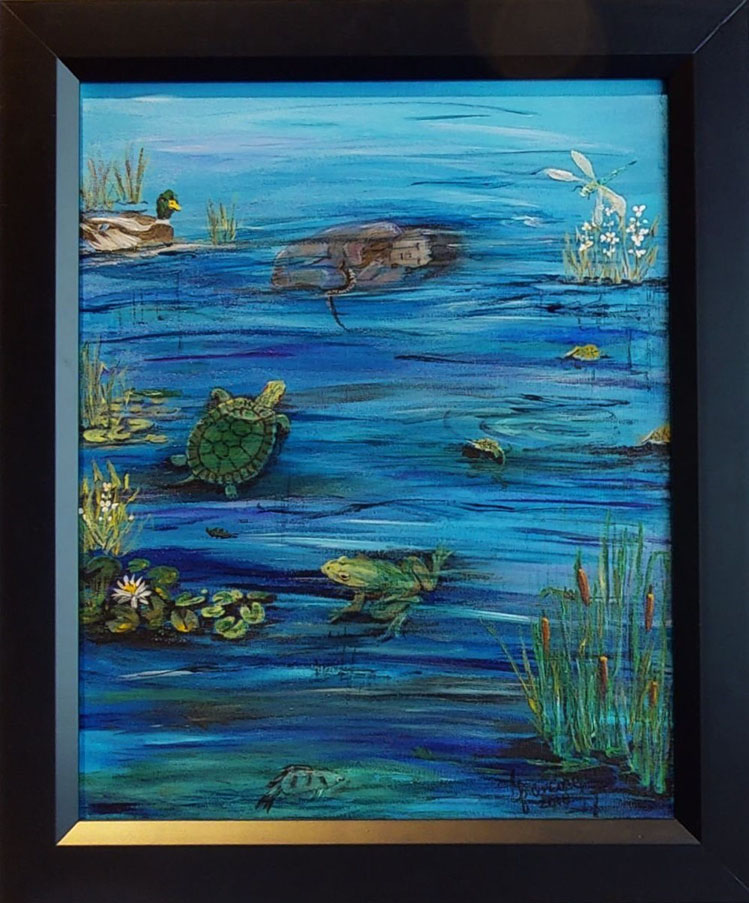
Francine Poitras Jones (Nulhegan Abenaki), Water is Life, 2019, acrylic on canvas, 16 x 20”. Nebizun: Water is Life, is a “living, breathing exhibition,” curated by Vera Longtoe Sheehan, founder of the Abenaki Art Association. The exhibition brings together artists from four recognized tribes from the Champlain Valley and the Connecticut River Valley for its fourth stop on a two-year tour. Nebizun (Abenaki for medicine, whose root nebi means water) metamorphosizes in each curatorial iteration. A vital part of Abenaki art and culture is stewardship of the land, N’Dakinna (our homeland). Explains Sheehan, “The Abenaki people know how essential water is to foodways, medicine, and everyday activities that may be taken for granted.”
Many works are influenced by activist elders. Nebizun is inspired by Grandmother Doreen Bernard’s ‘water walk’ from Nova Scotia to Maine to pray for an abundance of water. Another inspiration is the Standing Rock crisis and art activism by Grandmother Willi Nolan: “Our waters are our highways.” Only Native American people were at Standing Rock—the word was spread via social media. No Pipelines, a drawing by artist JES, was created to share through those channels. Francine Poitras Jones’ Water is Life painting is a direct expression of this protest, “…it was my reality…the painting flowed from me, much like the water that sustains life.”
The exhibition takes visitors through several watershed topics while mirroring Abenaki making and way of life. Traversing a long space, each stop works like a tributary. The exhibition is peppered with water facts that will make you pause the next time you make a cup of coffee, and more. Another tributary begins with images of creation and Standing Rock, then flows into the importance of wetlands as protectors highlighting duck-decoys made from cattails, netmaking, fishing implements and birch, a vital material in canoe making and creating “biting patterns” in pieces of art. At one end of the space is an arresting photo of ancestral rock carvings—petroglyphs of the faces in Bellows Falls, VT. The installation continues with beading and pottery, and concludes with detailed maps, calls to activism, and digital paintings Across the River by Hawk Schulmeisters that evoke pollution in water.
— Kelly Holt
- Daisy Dew-diamond
Standard Space, Sharon, CT • standardspace.net • May 26–June 25, 2023

Louise Sheldon, Tablecloth Friend, 2022, watercolor on paper, 39¼ x 27¼” (99.4 x 68.9 cm). Nestled in a small, historic, quintessential Connecticut town, Standard Space Gallery is anything but standard. In the quiet, clean space of this intimate studio-gallery, a revolution is happening. Within that revolution, Louise Sheldon’s work has found itself a worthy temporary home.
Although owner and photographic artist Theo Coulombe did not intend to stay in Sharon when he left Brooklyn, he has carved out a space for himself and other artists who push boundaries. Without setting out to do so, Coulombe has established a gallery that places emphasis on under-represented voices in the art community and on art that speaks for itself. “I’m not a gallerist, I’m an artist who owns a gallery,” Coulombe told this writer. It is this emphasis on artists first and gallery politics second that leads him to collaborate and to use his space to elevate the art and voices of fellow artists.
Louise Sheldon’s upcoming show, Daisy Dew-diamond, is one such collaboration. Described by Coulombe as “psychedelic,” Sheldon’s work is full of captivating patterns, unbelievably vibrant watercolors, and visuals that leap off the paper. A unique color palette and repeating motifs draw
a clear line from one piece to the next. Once you have seen Sheldon’s art, you would recognize her style anywhere. With her use of faces and eyes, Sheldon’s work confronts you in a most literal way. The dynamic of viewer-subject is turned on its head as the observer becomes the observed.Tablecloth Friend engages the simple and recognizable checked pattern of a picnic tablecloth. The face of the friend is kind and understanding, surrounded by a hazy aura of glowing sunset orange. Silly Rules is one of the few pieces that does not contain a characteristic face. Instead, big contoured drips fall from the top of the paper and sunny flowers overlay a hypnotic series of concentric circles reminiscent of a ripple in the water. This piece is a culmination of the bright colors and youthful patterns present throughout Sheldon’s work.
Simultaneously modern and vintage in aesthetic, Sheldon’s art draws you into a world of childish whimsy that elicits a pang of nostalgia and seems to deposit you into a dreamscape where flowers and tablecloths have faces and all the rules are silly.
— Autumn Duke
- Sky Power: Beckoning Color
Provincetown Art Association and Museum, Provincetown, MA • paam.org • May 5–June 25, 2023

Sky Power, The Gift, 2016, oil on canvas, 24 x 30″. Photo: Kevin Thomas. Two thousand twenty-three continues to be memorable for Sky Power, who has lived and worked in Provincetown, MA, since 1976. She exhibits regularly at Berta Walker Gallery, Provincetown’s home to generations of creatives defining America’s oldest art colony. “Our connection is deep, as is our mutual love of art and color,” Power says of Berta Walker.
Her painting Our Changing Climate (2021) was recently selected for a Provincetown Art Association and Museum (PAAM) juried exhibition. A carefully balanced synthesis of abstract and figurative elements presents the outline of a cottage swirling in hues of blue, while waves of yellows and oranges pull from a distance. Dynamic brushy strokes, created with thinned oil paints, lend a symphonic quality to this masterwork.
And now her solo exhibit, Sky Power: Beckoning Color, is on view at PAAM. Christine McCarthy, PAAM’s chief executive officer and exhibit curator, says of Power’s diverse body of work, spanning five decades, “It is driven by strong composition and color-as-form, created in the language of abstraction. Influenced by Hans Hofmann’s students, Power’s paintings seek to show the connection between representational and abstract art.”
In The Tides of Provincetown: Pivotal Years in America’s Oldest Continuous Art Colony (2011) Alexander J. Noelle, assistant curator of European paintings and sculpture at the Cleveland Museum of Art, describes Power’s ties to the gravitational pull of the Outer Cape. “Drawn to locales with vast skies and violent seasonal shifts,” Noelle writes, “Power creates paintings that evoke the feeling of a storm on the sea or a burst of clouds in the sky. The rolling waves, veils of haze, and distant vistas of the Cape are powerful sources of aesthetic inspiration.”
The Gift (2016) offers abstraction with a touch of Surrealism, maintaining the lyricism, and translucent colors, of her animated style. “I consider myself a colorist,” Power says. “I dream and thrive in the light, the colors, and the infinite horizon of the Cape.” A white droplet dangles from a string poised on the tip of a gestural zip, while a blue ribbon flirts with cottony pink. For Power, it is a portal into a dream. “I feel my work bridges the gap between me and what is on the other side, the other world.”
— Susan Rand Brown
- TURN OF PHRASE: LANGUAGE AND TRANSLATION IN GLOBAL CONTEMPORARY ART
Bowdoin College Museum of Art Brunswick, ME Bowdoin.edu Through June 4, 2023
Many years ago, a trucker hat with a Jenny Holzer truism on it, “Protect Me From What I Want,” came into my possession. Donated to the local Ladies Aid Society the hat eventually found a new home atop the head of an elderly Maine islander, its pronouncement drawing smiles and questioning looks on the mailboat ride to Great Cranberry Island.
The pieces that make up “Turn of Phrase,” curator Sabrina Lin’s remarkable exhibition, use diverse means to deliver their messages. Some, like Barbara Kruger’s nine-piece photolithographic and silkscreen print Untitled (we will no longer be seen and not heard), 1985, aligns with Holzer’s direct messaging although the actual words combined with found images are rebus-like in their presentation. Kruger, too, wants to, as Lin puts it, call into question “what or who is not seen and or heard.”
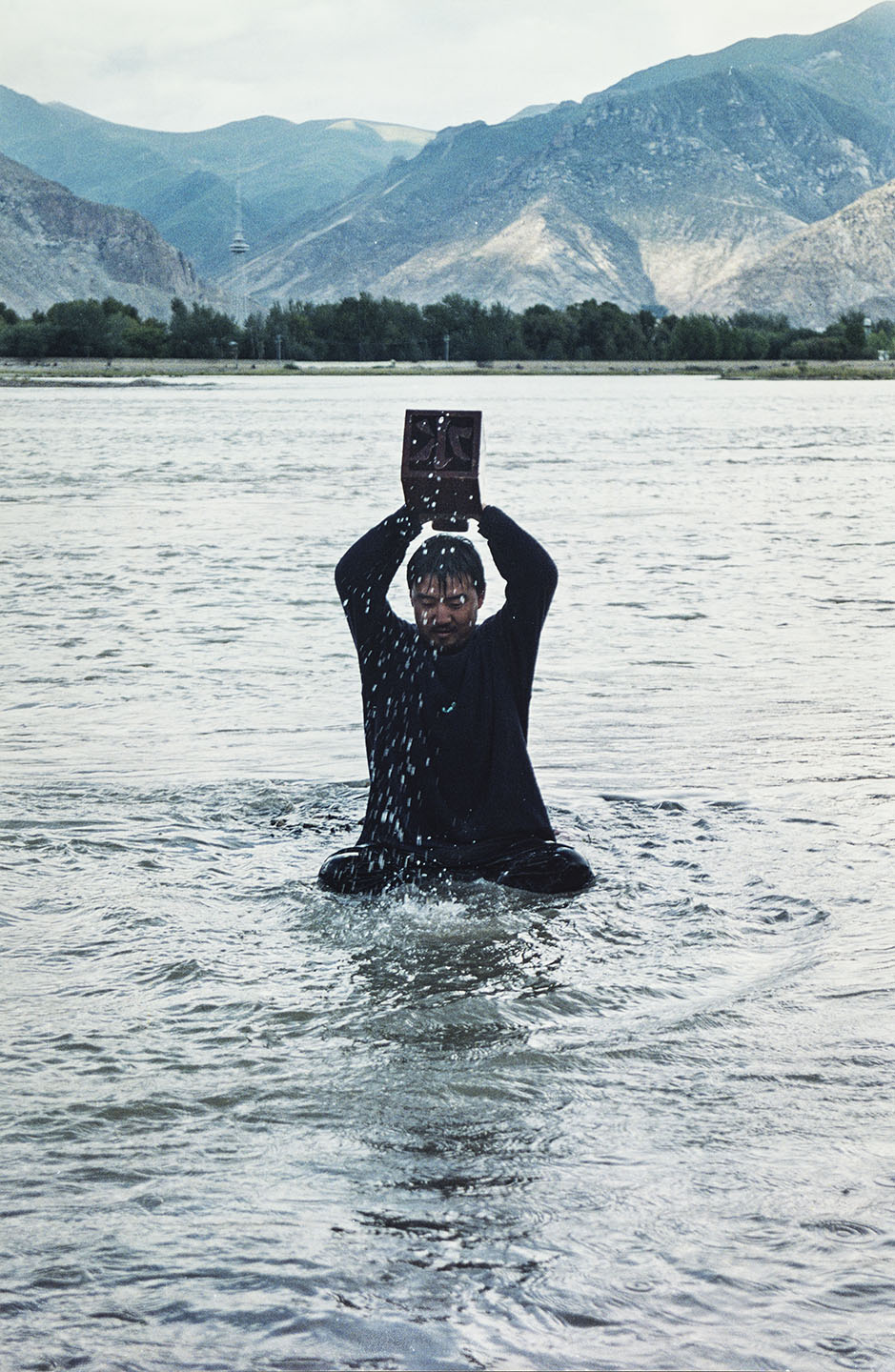
Song Dong 宋东, Stamping the Water (Yin shui 印水), (detail) 1996. From set of 36 digital color photographs. Gift of the Jack and Susy Wadsworth Collection of Contemporary Chinese Photographs, Jordan Schnitzer Museum of Art–University of Oregon. 2018:28.14a-aj. © Song Dong, courtesy Pace Gallery In some cases, the viewer must turn to Lin’s comprehensive catalogue essay to uncover the textual element. One example is Song Dong’s Stamping the Water, 1996, which consists of 36 still photographs from the artist’s hour-long performance in the Lhasa River in Tibet. While we can appreciate the stop-action images of Song lifting and slamming something in the water, when Lin relates that the object is a large wooden block carved with the Chinese character for “water,” a whole other level of understanding and admiration takes place. The existentialism of the act redoubles, Sisyphean in its repetition.
Lin’s guidance also comes in handy while studying Yanagi Yukinori’s Loves Me, Loves Me Not, 1997, a large wool carpet on jute backing with a semé of brass chrysanthemum petals. The curator explains how the lines of woven text represent the title’s phrase in languages related to Japan’s former colonies and the country’s indigenous populations. A gift to the Bowdoin Museum from the Marion Boulton “Kippy” Stroud Foundation, the piece was created in collaboration with the Fabric Workshop in Philadelphia.
The most disturbing piece in the show is Hung Liu’s Western Pass, 1990. The artist borrowed the principal image from a photograph taken during the Boxer Rebellion by British botanist Ernest Henry “Chinese” Wilson (1876-1930) showing two female prisoners hung crucifix-like on crude wooden easels about to be executed. The calligraphic poem in the middle, by Wang Wei (699-761 AD), “sensitively humanizes” the figures, writes Lin, who provides the translation: “Wait till we empty one more cup [of wine]—West of Yang Gate there’ll be no old friends.”
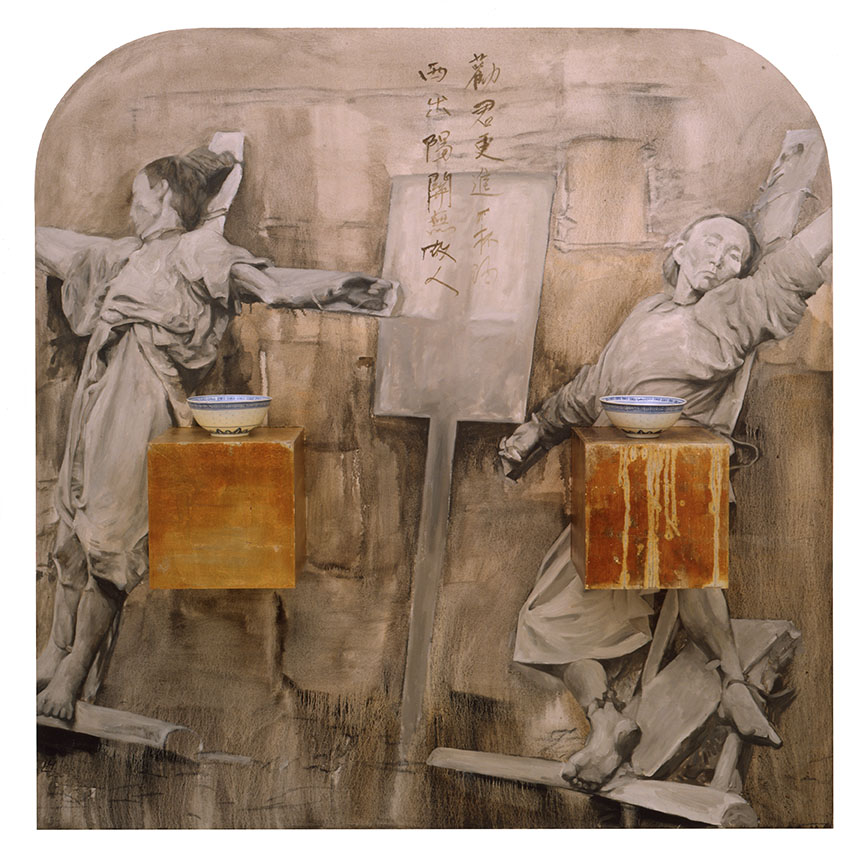
Hung Liu, Western Pass, 1990. Oil with silverleaf on wood, ceramics on canvas, 60 x 60 x 10 in. Bowdoin College Museum of Art, Museum Purchase, Lloyd O. and Marjorie Strong Coulter Fund, 2021.53. Courtesy Nancy Hoffman Gallery Lorna Simpson’s Waterbearer, 1986, and H.S., 1992, deploy language in different but equally forceful ways. In the former, a Black female figure, photographed with her back turned, empties a pitcher and plastic carton of water. Below her in block letters we read, “She saw him disappear by the river, / they asked her to tell what happened, / only to discount her memory.”
The sense of subjugated knowledge in Waterbearer carries over into H.S., a pair of dye diffusion color Polaroids showing a headless Black female figure holding a high school yearbook open to spreads of student headshots. You need to look closely to read the words “subjugation” and “indoctrination” inscribed repeatedly on the Plexiglas overlay. The vertical piece, nearly 50 inches tall, brings to mind ancient Greek caryatids but in this case the woman holds up not a building but a piece of charged personal history.
“Like art,” Lin writes at the beginning of her catalogue essay, “language acts as witness to societies and cultures, and becomes a mirror through which we see and situate ourselves in relation to the world.” Her selection, which includes work by Marta María Pérez Bravo, William Kentridge, Glenn Ligon, Qiu Zhijie, Meleko Mokgosi, Shirin Neshat, Wang Tiande, Xu Bing, Luis Camnitzer, and Jeffrey Gibson, highlights a compelling line of visual/textual works that continues today (see, for example, the recent work of Chloë Bass). Thanks to Lin’s deft and intriguing assemblage, we come away with a more nuanced view of how word and image may lead us to new understanding of disparate worlds.
–Carl Little
- LOOK UP: Skyscapes by Berta Burr
The Left Bank Gallery • North Bennington, VT • leftbankcalendar.org • Through January 31, 2023
In this noise-infested world, it is a balm to come upon Berta Burr’s serene series of sky portraits at Left Bank Gallery. This writer must disclose that he is a sucker for clouds, and did not find it hard to feel an affinity with the 26 paintings of varying sizes, some intimate (8 x 10″), and some expansive (30 x 40″). It also helps that Left Bank, as managed by artist Rhonda Ratray, is a perfect venue for a show of this scale as it is set in a former 19th-century bank with aged wood floors, direct lighting, large windows, and is a single space venue. From one point in the room, it seemed as if there were broken points of sky poking in, dropping tumbling bits of cotton.
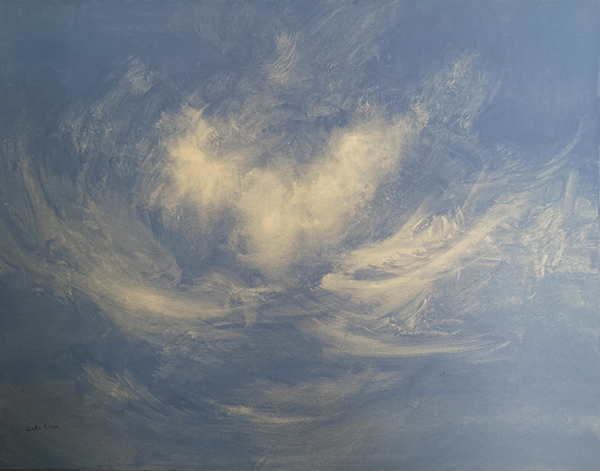
Berta Burr, Untitled #2, oil on canvas, 22 x 28″. Courtesy of Rhonda Ratray. Burr views the world “with a degree of detachment that allows for the possibility of beauty,” though I did not detect aloofness here. Burr’s eye is present, as is her hand, in the compositional choices and the modes of pigment application. What is there, for certain, is the beauty. The strength is in how she builds tension between the amorphous clouds, modeled, sculpted, and rendered as poetic beings set against the various shades of blue or crepuscular light: cerulean, azure, sapphire, arctic, or mustard, lilac, mango. Each view is a snapshot of a meteorological moment, a nod to Constable, and a gesture of respect for a part of the world under which we exist yet are often too frantic to notice. Burr’s imperative is that we “Look Up,” and when we do, as with her paintings, we will be pleasantly surprised, if not blessed.
The paintings are all untitled, allowing for freedom of interpretation, of self-labeling, of Wordsworthian immersion. Who does not want to wander within each of these windows? Clouds are merely water vapors, ice crystals, yet Burr sees beyond the scientific into the poetic. In Untitled 14, a flurry of darkened petals flows outward, a scumble of pigments, in a blue frame. In Untitled 15, Burr has arranged a combination of cirrus and stratus in a somber sky. The light play in each wisp indicates the emotional levels these heavens can assume.
This show connects to Constable, Debussy, and the Tang landscape painters, as it gives us a moment of peace, of magic, and of music, which amble on above, in a gentle and wise silence.
—Bret Chenkin
- Outsider Art: Harnessing Color
Jamestown Arts Center • Jamestown, RI • jamestownartcenter.org • January 27–April 1, 2023
Hasten spring’s arrival with a visit to Outsider Art: Harnessing Color at the Jamestown Arts Center. Co-curated by the art directors of the nonprofit Looking Upwards, Melissa Seitz, Vince Ruvolo, and Casey Weibust, the exhibition brings together “Outsider Art” commissioned and collected by organizations through the Northeast that work with artists with disabilities.

Robert Stengel (Out of the Box Studio & Gallery), Pennsylvania, watercolor on map, 15½ x 27″. The expansive galleries of the Jamestown Arts Center will be filled with work in all different media: from video to ceramics to canvas to bottlecaps, the exhibition promises to be dimensional and textured, utilizing all resources on hand. While Looking Upwards exhibitions in years prior focused on the technical frameworks of weaving and patterning, this year’s theme, Harnessing Color, was chosen in part as a balm to the depths of winter.
The center of the show will be the “wall of orange.” The six contributing organizations were tasked with either making new work or looking to their collections for works in orange to fill up the space, with the sensation of “walking into the sun,” says Weibust (Out of the Box, Jamestown, RI). She is especially excited about the collaborative installation; the works are pre-selected by the organization yet installed as an improvisational act, determining which works “play nicely” together—creating evocative connections rather than organizational ones.
An ”outsider artist” is one who hasn’t had conventional art education. A controversial term, this third iteration of the biennial event was entitled as such to draw connections with the annual Outsider Art Fair in New York, also in January, and to elicit conversation around its meaning. Seitz (Downtown Designs, Newport, RI) said “the thing I love about outsider art is that it’s often so exciting and surprising.” Outsider art often carries implications of naivete, but/and it can also circumvent the trends that seem to overdetermine contemporary art.
Of the biennial, Ruvolo (Studio 57, Middletown, RI) notes that it helps artists develop ongoing bodies of work, supporting their visibility and professionalization, and has aims to create (inter)national networks for artists with disabilities. Harnessing Color, especially, shows both the “joy of making and the joy of the maker.” This joy is contagious in discussing the plans for the opening and programming, which will include makers workshops and panels with artists and guests. Or, as Weibust pithily puts it: “Why not meet up and do something really fun and special?”
—Elizabeth Maynard
- Equals 6: A Sum Effect of Frank Bowling’s 5+1
University Hall Gallery, UMass Boston • Boston, MA • umb.edu • Through February 18, 2023
Frank Bowling’s Americas, currently on view at the Museum of Fine Arts, Boston, has a satellite exhibition at UMass Boston’s University Hall Gallery. The centerpiece of a multifaceted, collaborative project has as its starting point the landmark 1969 exhibition 5+1 at SUNY Stony Brook, which was curated by Bowling to spotlight the underrepresented abstract work of five Black artists and himself. The five, all men, were Melvin Edwards, Al Loving, Jack Whitten, Daniel LaRue Johnson, and William T. Williams. Equals 6 brings Bowling’s impulse into the present by featuring the varied work of women artists and Queer male artists—Dell Hamilton, Glenn Ligon, Steve Locke, Julie Mehretu, Destiny Palmer, and Howardena Pindell—and thus provides an edifying look at an expanded notion of abstract work today.

Dell Marie Hamilton, Systems Won’t Save Us, (Otherwise Known as Frankenstein), 2022, mixed-media on paper, 100 x 150″. Photo: Jon Bakos Photography. For example, in Homage to the Auction Block, Locke reworks Josef Albers’ pristine nesting squares and inserts the geometric shape of an auction block at the painting’s focal point. An exercise in color and contrast, it also conveys a message about slavery and oppression. Mehretu’s print, Slouching Towards Bethlehem (a title echoing both W. B. Yeats and Joan Didion), encompasses a whirl of anxious markings that suggests a fraught moment of discordant jazz…or conflicted humanity. An energetic, monumental sculptural drawing, Systems Won’t Save Us, (Otherwise Known as Frankenstein) by Dell Hamilton bursts forth to proclaim the center won’t hold, the systematic solutions won’t work, and that as a person who is neuro divergent she won’t assimilate. In the 12-minute, scripted video Free, White and 21, the well-known abstract artist (and SUNY Stony Brook professor) Howardena Pindell recounts her searing experiences of racism as a young Black woman.
As a means for the MFA to further expand its community connections and audiences, the laudable project, which includes an online component, enabled a small group of UMass Boston students to participate in the research and curatorial process. “Connecting our students with these artists and curators” says gallery director Samuel Toabe, “has given them agency within these institutions. We want to show them that, like Bowling, they too can subvert the art historical discourses around abstraction and representation by asserting their voices and getting involved.”
—Jack Curtis
- Sargent, Whistler & Venetian Glass: American Artists and the Magic of Murano
Mystic Seaport Museum • Mystic, CT • mysticseaport.org • Through February 27, 2023
Among over 115 artworks on view at Mystic Seaport Museum’s exhibition Sargent, Whistler & Venetian Glass sits Murano, Hermann Dudley Murphy’s 1907-dated painting of the titular island off of Venice, plunged into an impossibly thick wash of fog. Rendered in an emblematic blue that both signals nocturnal dimness and morning’s luminosity, the seascape veils the island of incomparable glass mastery with a malleability not indifferent from molten lava’s pliable nature during its metamorphosis into rigid glass.

Maurice Brazil Prendergast (1858–1924), Fiesta Grand Canal, Venice, ca. 1899, glass and ceramic mosaic tiles in plaster, 11 x 23″ (27.9 x 58.4 cm). Williams College Museum of Art, Bequest of Mrs. Charles Prendergast, 95.4.79. Courtesy of Mystic Seaport Museum. The exhibition, which features paintings, drawings, and prints, in addition to glass objects, assumes the late 19th century American artists’ fascination for Murano glassmaking tradition to explore the formation of mobility, cultural exchange, patronage, and art commerce among the era’s intelligentsia. In doing so, the juxtapositions of flamboyant Venetian canals, locals in idyllic postures, and ornate glass vessels—blown by Murano masters such as Giuseppe Barovier or Toso Brothers and collected by Americans—chronicle the blossoming of an American art determined to carve its global footprint whilst looking up to Europe for criteria of aesthetic and inspiration.
John Singer Sargent, who was in fact born in Florence to American parents, commences the show with a 1913-dated, lucidly-illustrated oil painting of Church of San Stae in which the building’s marble facade is washed with a dramatic veneer of sunlight and shadow. La Serenissima’s aquatic marvel inspired Maurice Brazil Prendergast both in canvas and glass. The Canadian born painter’s one-year-and-a-half sojourn in the Queen of the Adriatic in 1898 yielded two renditions of Venetians walking on the Riva degli Schiavoni with brightly-colored parasols. In the oil painting, circular umbrellas dot the crossing while the passersby in lavish dresses march toward a line of cafes facing the St. Mark’s Basin. The bird’s-eye view is rather abstracted in its glass and ceramic mosaic tile adaptation (1899) with a medley of rounded and geometric bits: umbrellas are minimized into densely arranged circles, blended with brown or blue rectangular tiles reminiscing the cobblestones and the sea that blanket the city. The sun that illuminates the water filling the canals finds a similar echo in glass when the light hits the blue mosaics in a similar gleam.
—Osman Can Yerebakan
- Amendment XXIX Right To Privacy
Canal Street Gallery • Bellows Falls, VT • canalstreetartgallery.com • Through December 10, 2022
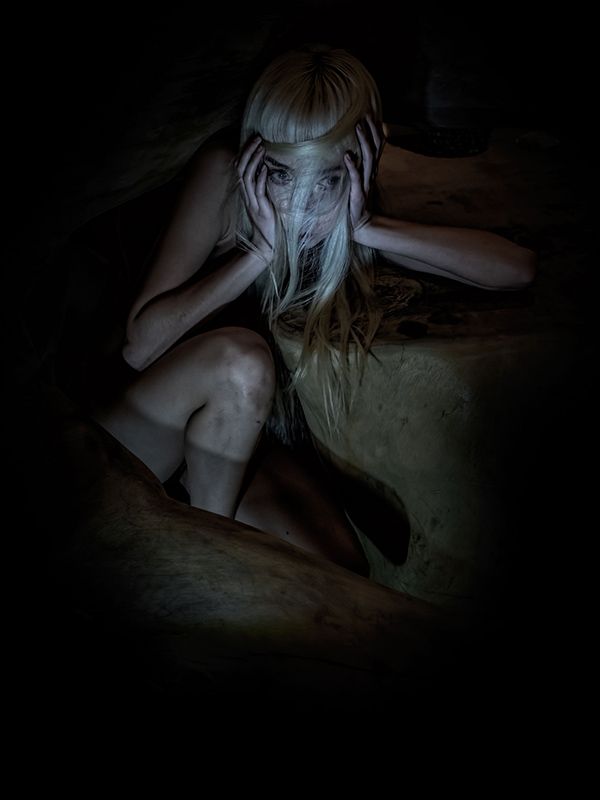
Yvette Hendler, There’s No Place Like Home, 2019, archival luster pigment print. These times try people’s souls. Michael Noyes, co-founder of Canal Street Gallery, curates an antidote to this intrusion by highlighting privacy in The Amendment XXIX Right to Privacy, featuring regional artists, including Clare Adams, Nancy Fitz-Rapalje, Corinne Greenhalgh, Yevette Hendler, Roxy Rubell, and Jeanette Staley.
Noyes feels “the ‘implied’ right to privacy in the Constitution relied upon by the Supreme Court for nearly 50 years is not enough. A new Amendment must be proposed to define the American citizen’s right to privacy, and to protect these rights.” He believes that an individual’s privacy is enshrined. In response, Adams venerates Supreme Court Justice Ruth Bader Ginsberg in a rectangular portrait of colored glass. Justice Ginsberg faces us center stage as an icon, set in crimson, cloaked in black, and surrounded by a blue and white border. This hagiography makes sense as stained glass evokes religious tradition. Who better to idolize than Ginsberg.
Playing up to the Kafka-esque cyber invasion of our lives with ironic wit is Hendler’s There’s No Place Like Home. Hendler quips that all this prying into people’s homes is enough to “motivate [us] to dwell in a remote cave.” She created a self-portrait of herself crouched in a rocky space, clasping her ears. An ominous light flashes upon her face, saying—“We got you!”
Some artists defend women’s freedoms. Fitz-Rapalje painted a line of women a la “The Handmaid’s Tale.” They solemnly stand in A Grievous Disregard, Violated Virgins Carrying Unwanted Children. As she explains, “it calls to mind one of the ways Dobbs v. Jackson infringes on a woman’s elemental privacy.” The Biblical pall over these costumes, and the reference to virgins, emphasizes the implications of governmental misogyny. Joining in the solidarity of guerilla artists like Chicago, Kruger, and Ringgold is Greenhalgh’s embroidered linen. Green-halgh sews text into kerchiefs—transforming traditional women’s objects into powerful talismans. Her piece Get It In Your Head Women Are Not Going Back To The Nineteen Fifties, exemplifies the general tenor of the show.
Staley’s American Red Fox, 2022 at 20 x 30″ offers an appropriate conclusion. This collage of an Audubon fox and Chinese motifs alludes to things being trapped. Yet the fox is snapping back, as must we all.
—Bret Chenkin
- Mariana Ramos Ortiz: Contra viento y marea
Central Contemporary Arts • Providence, RI • centralcontemporaryarts.org • Through December 8, 2022
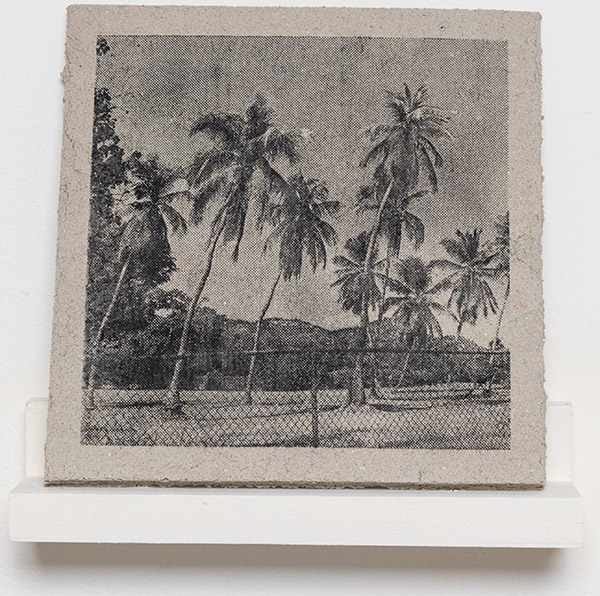
Mariana Ramos Ortiz, Caña Gorda, 2022, screenprint on sand, 8 x 8″. Courtesy of the artist. Even the title of Mariana Ramos Ortiz’s debut exhibition at the newly opened Central Contemporary Arts evokes a clever precarity, one of the threads elegantly woven through her exhibition of (un)familiar forms in sculpture, print, and video. Contra viento y marea literally evokes their medium of sand, subject to both wind and tide, and idiomatically calls for resistance against seemingly unstoppable forces. Ramos Ortiz’s semi-permanent works conjure fantasies of Puerto Rico in order to crumble them.
Absent are the azure blues of a tropical paradise. We are not welcomed onto white sand beaches, but are asked to consider the literal and poetic metaphors of sand—an oft-contested material in coastal economies. For instance, without a fixing agent, the cast-sand Breezeblocks (verja) doesn’t possess the protective function of their concrete, hurricane-resistant namesake. Their sturdy form belies their fragility, while also recalling the indelible presence of colonialism, as in this architectural reference to mid-century modern U.S. design and material, visible in sites such as Levittown, PR, built in 1963; Ramos Ortiz’s significations are multiple. Similarly, the sandbox constructions of Playgrounds refer to the exploitation of the island as a “taxless playground of the rich.” The photograph printed on the sand depicts the artist’s hometown of Cabo Rojo. In this material format, the landscape is imagined both as vulnerable to shifting conditions yet protected from touristic intrusions. For all the installations’ precarity, the artist continually returns to themes and forms of protection, or as co-curator Melaine Ferdinand-King writes of the Tormenteras, “[t]he hurricane storm shutters…offer a reading of the tropics that reflect its constant fluctuation between fragility and strength…and affirm everyday materials as sites of resistance.” Ramos Ortiz invites us to embody her fluency in conceptual materiality in La Peregrina, a massive ouroboros of a sand-hopscotch board, where we are invited to play, to fail, to resist, and re-signify.
At the time of the show’s opening, Puerto Rico is in the direct aftermath of Hurricane Fiona, impacted just before the fifth anniversary of Hurricane Maria. The legacies of colonial exploitation which leave the island vulnerable to increasingly frequent climate disasters make all the more urgent such explorations of futurity, as Ramos Ortiz deftly shapes and reshapes.
—Elizabeth Maynard
- Robin Tost: Scrap Metal Quilts
Cahoon Museum of American Art • Cotuit, MA • cahoonmuseum.org • Through December 23, 2022

Robin Tost, Spirit Bear, 2020, mixed metal and wire. Robin Tost is a dedicated practitioner of re-cycling and re-creating, as fully evidenced in her exhibition, Scrap Metal Quilts, at the Cahoon Museum of American Art. Western Massachusets-based Tost collects—you name it—automotive scrap, gutters, shed tin, tin cans, advertising signs, and other found materials from roadsides, transfer stations, and scrapyards; cuts them by hand into “patches” to be fit into a quilt design, traditional or free form; and uses a drill press to punch precise holes into the patches. Then she sews the pieces together with wire. The results are wonderful.
The works range from her first full-metal quilt, Rust (2008), her paean to corrosion comprised of pulls, grates, and tools plus washers, wires, and screens, to Kubo Totem, a fierce copper-tinged icon, created for this show, offset by scintillating Klimt-like gold and silver disks and squares.
For Crazy Quilt, which diverges from traditional quilt patterns, Tost designed each square individually and then assembled them into a captivating, dizzying layout. Each of the 63 squares would please a lover of abstract expressionism.
Some works are representational, such as Winter Sunrise, with striated gutters that resemble birch trees, while others are evocative, such as Fountain, with its flowing patchwork of many blues. Also on view, a few assemblages made of found objects of wood and metal, including the whimsical Trojan Chicken—on metal wheels.
Tost has recently transformed her flat quilts into large, more realistic, 3-D creations. Spirit Bear, arrayed in white, silver, and icy blues patches, is Tost’s salute to the mythic white bear. Her exuberant Phoenix ascends from a side lawn of the museum, while fanciful Cecilia, a giant sea serpent, slithers through the museum’s front lawn. All three statues have enjoyed stays at The Mount’s annual SculptureNow exhibition in Lenox, MA.
Found art and refuse transformed into art have always prompted viewers to see anew the things and materials that comprise our quotidian lives—and overload our landfills. To reframe an old adage, “Junk is beautiful in the eye of the beholder.” Here we are the fortunate witnesses to Tost’s masterful fashioning of the discarded into the magical.
Plus, on view from November 9–December 2022, Andrea Moore: An American Artist and Her English Garden and Pauline Lim: Travels in My Armchair.
—Jack Curtis
- Gladys Triana: A Path to Enlightenment 1971–2021
University of Saint Joseph and Fairfield University Art Museum • West Hartford, CT and Fairfield, CT • usj.edu and fairfield.edu • Through December 17, 2022

Gladys Triana, Nautical Rose, 1998, mixed media on canvas. Courtesy of the artist. © Gladys Triana. In 1984, Gladys Triana ripped up charcoal, pastel, and tempera drawings, many based on portraits of her Cuban-born family—a diaspora living in three countries at that time. In this physical and psychically ritualized act, she demarcated her practice: “I looked at them and said: this is not the work. The work is what I’m going to make of them.” Featuring an unsettling visage, the large-scale collage Homage to Munch (The Scream) is made from those drawings and is on view in Gladys Triana: A Path to Enlightenment 1971–2021. In the catalog, Adriana Herrera Téllez writes that Homage to Munch “establishes a paradigm for Triana’s aesthetic ruptures: it is the beginning of a long series of works, and it is a cry of expressive freedom….”
Throughout this two-venue survey, we see Triana’s “aesthetic ruptures” at play as she adds diverse media to her paintings—lace, stock market indexes clipped from the The New York Times, wooden dowels—and explores installation, sculpture, photography, and video. Named Beyond Exile at Fairfield and From the Female to the Intimate at Hartford, each venue distinctly frames her work, yet both include pieces from every era of Triana’s career and attend intersectionally to the Cuban-born, New York City-based artist’s life experiences; the influence of her studies in philosophy; the incorporation of feminism, especially relating to the body; and her spirituality.
This writer found Triana’s paintings and installations from the 1990s to be the strongest; however, her entire oeuvre is striking for its risk taking, its unexpected and elegant materiality, and in the paintings, its confident brushwork and refined sense of color. Two works that exude these qualities are The Path of Memory (1995), which addresses immigration, time, and exile; and the painting Nautical Rose (1998), a brilliant minimalist redux of Cuba’s iconic “Virgin of Charity” image. It is key to visit A Path to Enlightenment in person if one is to fully comprehend Triana’s subtle, yet dynamic, color palette, attention to surface, and voluminous scope and scale. Experienced in the galleries, the individual works become more than the sum of their parts—they become what we make of them.
—Terri C Smith
- 52 Artists: A Feminist Milestone
The Aldrich Contemporary Art Museum • Ridgefield, CT • thealdrich.org • Through January 8, 2023
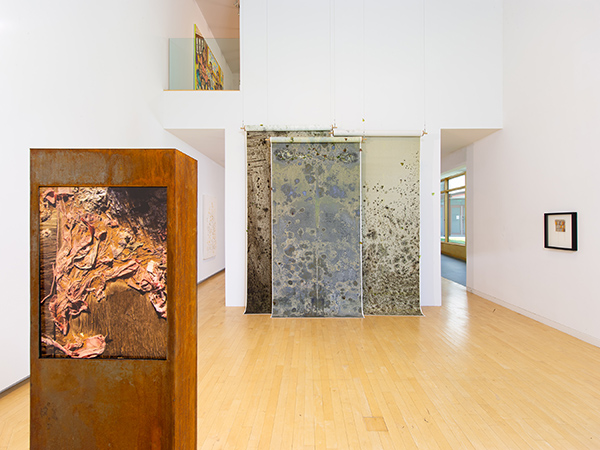
52 Artists: A Feminist Milestone (installation view). Photo: Jason Mandella. Strong research, diverse artistic practices, and animated feminist inquiry bridge two group exhibitions that were curated 51 years apart at The Aldrich—the historic Twenty Six Contemporary Women Artists, organized by pioneering curator, activist, and writer Lucy Lippard in 1971; and 52 Artists: A Feminist Milestone, an intergenerational homage and contemporary extension of Lippard’s show that adds 26 artists who are born after 1980, identify as female or nonbinary, and are influenced by feminist art practices. Curated by Alexandra Schwartz and Amy Smith-Stewart, 52 Artists presents works by all but three of the participants from the 1971 show alongside new artists whose inclusion “underscore[s] the original exhibition’s enduring legacy.” In 52 Artists, each gallery is a heartfelt homage to second-generation feminist artists—whose works appear shoulder-to-shoulder with their younger peers—and a bellwether for understanding contemporary ideas around gender identity and intersectional feminism.
Since some of the works from Twenty Six Contemporary Women Artists could not be located or were made using ephemeral materials, 52 Artists includes a mix—works from the original show, commissioned recreations, photo documentation, and representative pieces made by those artists in the late 1960s/early 1970s. Importantly, the exhibition often includes more recent works by these artists, showing how their art has changed over the years. The new generation of exhibiting artists has an equally diverse range of approaches and materials, yet are more international and more diverse in terms of race, sexual orientation, and gender identity. While the works from Twenty Six Contemporary Women Artists barely tackled political topics, the art by these younger artists frequently addresses politically charged themes, exploring Black queerness, transgender imagination, ableism, the Asian Diaspora, immigrant identities, cultural appropriation, and more.
In the galleries, the curators draw connections within and across generations using subject matter (the figure, the environment, marriage), materials (earth art, textiles, soft sculpture, assemblage), and tone (dystopic, celebratory, indexical). Their attention to the visitor’s phenomenological experience—the body moving from artwork to artwork and room to room—make 52 Artists as viscerally and visually engaging as it is rigorous and historically important. It is—to quote a phrase from Grace Glueck’s 1971 review of Twenty Six Contemporary Women Artists—“well worth the trip to Ridgefield.”
—Terri C Smith - Many Americas: Art Meets History
Southern Vermont Arts Center • Manchester, VT • svac.org • Through November 27, 2022
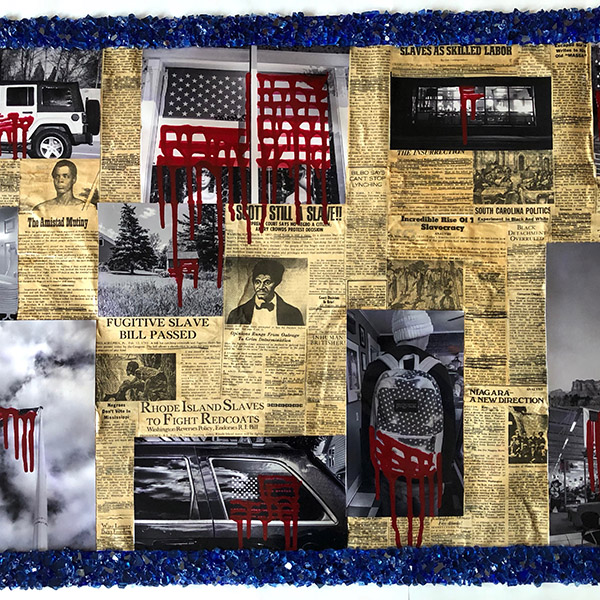
CoCo Harris, We Pledge Allegiance (detail), 2022, photographs (metallic paper), acrylic, archived newspaper clippings, archival ink, high gloss varnish, unstretched canvas, shards of broken mirrored blue glass, 25 x 108 x .25″. Despite America’s historic designation as a “melting pot,” this exhibit puts forth the theory that “we do not share a common history, and as a result, our divergent histories are the source of our troubled public discourse.” Guest curator Ric Kasini Kadour developed Many Americas: Art Meets History with SVAC during an eighteen-month-long research project funded by the Andy Warhol Foundation for the Visual Arts. Warhol himself would no doubt be pleased with the complexity and variety of the works presented.
We Pledge Allegiance by CoCo Harris, a monumental 3-foot by 10-foot collage, combines historical news clipping from The Black Chronicle and photographs of the American flag, often dripping blood. The yellowed newspaper behind the images is an inescapable testament to the history of racism in America. Nell Irvin Painter’s You say This Can’t really Be America, graphically illustrates diametrically contrasting views, as spoken in the everyday language of the subject portrayed.
Dream Catcher, by Michael Ryder (Ojibwe), employs a starkly moving archive of historical photographs to address bodily trauma and the displacement of native people. Dorothea Osborn’s Rear View is a six-panel fabric installation that shows layers of family history as sediment, underpinning and affecting the present, belying the saying “What you see is what you get.”
Ger Xiong’s Becoming White, an embroidered tapestry, speaks to the experience of Hmong refugees in America. Xiong traces a trajectory of assimilation and the inevitable distancing of his original Hmong culture. HAIRitage, a mixed media work by Erin Smith Glenn, celebrates Black hair culture and the highly original ways that hair is treated. It also emphasizes the importance of salons as community centers, sources of news and information, and sites of resistance and resilience.
These are just a few of the themes in this wide-ranging exhibit that cover a multiplicity of artists. Kasini’s decision to view history through their eyes provides both an intimate and expansive view. The “American experiment” is vibrant and alive, both in its accomplishments and shortcomings—and we all play our part. With this exhibit, the Museum has become a public square, and we are all invited to participate.
—B. Amore
- Mary Sherman: Visual Orchestrations
FPAC Assemblage Art Space at the Envoy Hotel • Boston, MA • fortpointarts.org • Through October 20, 2022
Mary Sherman, a highly skilled artist and presenter, outdoes herself with two visual and sound installations in the experimental art space sponsored by Fort Point Arts Channel and the Envoy Hotel. In the two pieces presented, Sherman collaborates with acoustic artists Florian Grond and Mathieu Corajod.
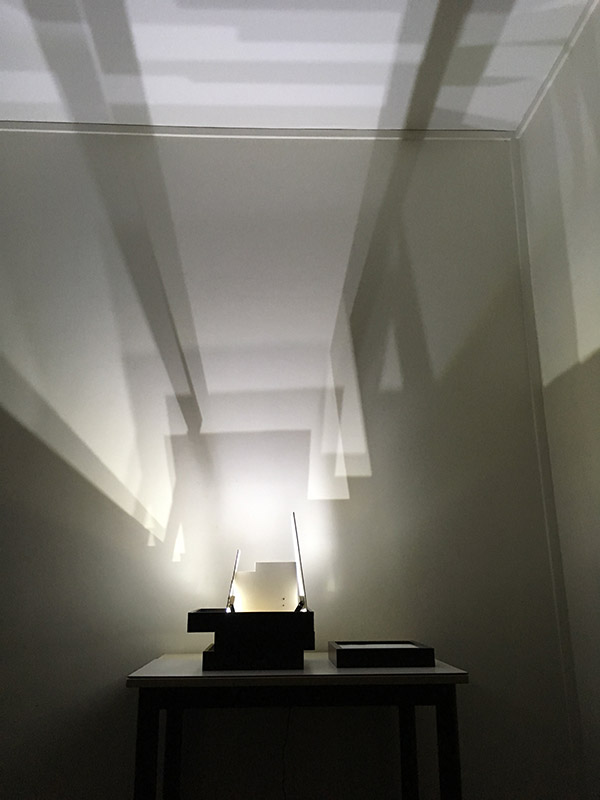
Mary Sherman, Black Box, wooden box, painting, matte board, motors, LEDs, circuitry, sound, and microprocessor; main structure closed: 7 x 10 x 13″; open with light effects: variable dimensions. Sound: Mathieu Corajod’s “Untitled, For a Box.” The installations are multi-sensory, and combine painting, constructions, light, and sound. In Delay, a small painting of Sherman’s is suspended within a central structure in a darkened room. When viewers pass before the spot-lit painting, a shuttered plate swings in front of it and a series of tiny blinds begin to pivot, illuminating the painting one section at a time, which slowly appears and disappears on the wall, accompanied by subtle sounds. The painting has been engineered by Grond through medical scanning, to translate the tactile strokes of the painting into sound thereby giving it “voice.”
Black Box is a smaller installation yet with big visual effects. Once the cover is removed, the small, handmade box “detects” our presence and it opens. Its content, a brilliant light, is revealed, then framed, projected, and choreographed around the room in a series of geometrics that Sherman relates to life’s barrage of daily inputs. Corajod’s composition, “Untitled for a Box,” is broadcast through the painted lid, which also doubles as a speaker. Black Box was formerly exhibited at Boston’s Ars Libri, Mario Diacono’s legendary avant-garde gallery.
Although there is clearly a strong conceptual underpinning (à la John Cage) in Sherman’s work, she is dedicated to the process of hand-fabricating many of the elements of the exhibit. The spareness and responsiveness of the installations to the viewer’s actions, intensifies the work’s emotional and psychological content.
Sherman’s question, “What if You Could Hear a Painting?” is answered by her innovative and imaginative response. Her collaborations with Grond and Corajod extend the reach of what is generally termed “art,” and incorporate the natural interplay of the senses in a constantly changing dynamic in which the viewer plays an integral role. Visual Orchestrations must be experienced in person for full effect. Don’t miss it.
—B. Amore
- May is Mural Month
Keene, NH •fpamonadnock.org • Through May, 2023

Rosemarie Bernardi, In_Title_Meant, 2021, solo installation of original linoleum cuts designed to be displayed in the public sphere. Photo: Peter Roos. New Hampshire leaf seekers have yet another outdoor visual delight in May is Mural Month—an ironic name for a gallery that is open 24/7/365. As a resourceful, innovative, and community-centered New England town, Keene is positioning its downtown as an outdoor gallery destination. In 2019, local residents organized, planned, and in some cases helped to design and execute 16 large Walldogs murals on local heroes (keenenh.gov/our-city/events/walldog-murals). Opening doors for that major undertaking was the work of Friends of Public Art (FPA) who in 2016 championed the idea of local artist and then professor at Keene State College (KSC), Rosemarie Bernardi. She conceived of this inside-out, brick-and-mortar gallery where curated art is freely available to the public.
Based on large-scale printmaking and the early 20th-century eco-friendly postering method of using wheat-paste as a reversible adhesive, Bernardi’s plan features regional, national, and international artists’ work alongside KSC student projects, mounted directly on the old brick walls. FPA negotiates and liaisons with building owners, city council, the Historic District Commission, and regional nonprofit Arts Alive!, building relationships that Bernardi describes as cooperative, supportive, and rewarding. After a year or so, she and a small team of volunteers help remove the work using a steamer and plenty of elbow grease so that the wall is ready for another installation. There is an art to the entire process. “All of it we’ve learned by making wonderful mistakes,” says Bernardi.
There is no official map to the wheat-paste installations as they rotate around Keene. Visitors can find Bernardi’s own 2021 installation In_Title_Meant along Diphthong Alley, a thematic series of hand-cut linoleum prints exploring text and image, some with color and one stitched with thread. The work holds aloft multiple readings combining the enigmatic lightness of Magritte tinged with something sinister and hidden. The fibrous paper fuses with the porous brick in such a way that the wall—all of its stories and everything it may hide—speaks through the image. As natural weathering mellows the hot-off-the-press print, the melding of wall and print introduces another layer of meaning out of the artist’s hands.
Regardless of the time of day or year, May is Mural Month has its alleys open!
—April Claggett
- BRIAN JUDE REARDON: PAINTINGS
ClipArt Gallery in collaboration with Atlantic Works Gallery • East Boston, MA • clippershipwharf.com/art/ • Through September 2022
What better celebration of summer than taking a road trip! Brian Jude Reardon offers us exactly such an imaginative opportunity. The Clip-Art Gallery is filled with ebullient paintings of vehicles that could be just the perfect mode of getaway, even if only in fantasy.
Happytown, a large painting of a classic Airstream trailer with a western landscape reflected in its mirrored stainless-steel surface, is an enticing introduction to a veritable lexicon of vehicles. Accompanying Happytown is a series of eight smaller Airstreams, executed in expressive alla prima technique. Many moods are reflected in the mirror surfaces of Call to the Bullpen, Snake Country, Candy for the Roadtrip, among others which are painted in varied light moving from dawn to sunset.
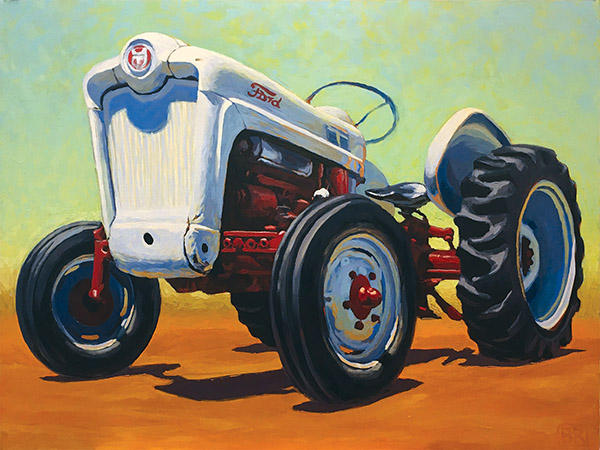
Brian Jude Reardon, Proud Ford, 2012, oil on canvas, 30 x 40″. On another wall, two iconic VW campers, Orange m&m and Blue m&m, stand like stalwart sentinels framing Candy Isetta and 1955 Isetta Sky. These post-WWII cars, produced in Germany, are even smaller than a Fiat 500. The spacious interiors of the square, practical VW busses filled with possibility, contrast with the almost toy-like curves of the Isetta’s fancifully painted surfaces.
Each vehicle has its own personality. Mini-Jeep, painted in bright orange and yellow against a flat cobalt sky seems to be grinning at us with its intricately designed grille and half lidded headlight “eyes.” Proud Ford looks as if it is an animal about to lunge out of the picture plane. Reardon is a sculptor in paint as he poses his subjects against flat planes of color so that they “pop out.” His palette contrasts hot and cool colors, and his use of pattern and detail create dialectics of subtle and exquisite tension.
It is impossible not to feel uplifted in the presence of these unique portraits. They are gentle, tender, meticulously rendered, and strong. The solid black of the tires grounds the vehicles and keeps them from taking off in flight. Reardon’s sense of humor and adventure infuses the paintings with infectious joy. His paintings offer an ecstatic experience of pure pleasure. View and enjoy them at this wonderful gallery on the edge of Boston Harbor.
—B. Amore
- PHILIP KOCH: ISLE OF DREAMS
Ogunquit Museum of American Art • Ogunquit, ME • ogunquitmuseum.org • Through July 19, 2022
One of the all-time go-to Maine landscape painting subjects is the island seen at a distance, a poetic symbol of retreat and separation—and an image of great visual beauty. From Thomas Cole and John Marin to Tom Curry and Brita Holmquist, those islands take center stage, often spruce-topped, shifting and sublime.
Maryland-based painter Philip Koch adds to this ongoing bounty in Isle of Dreams. The dozen or so oils on canvas or panel and handful of vine charcoal and pastel pieces in the show include a fetching selection inspired by the down east archipelago.
While the title of a painting may include a specific locale, as in Isle au Haut Morning 1, 2016, Koch creates his views from memories, often from different times and places. “They recall a state of mind and a remembrance of a dream,” he writes. With its bright yellow sky and atmospheric touches, the Isle au Haut painting might be labeled neo-luminism with a shot of modernist energy.
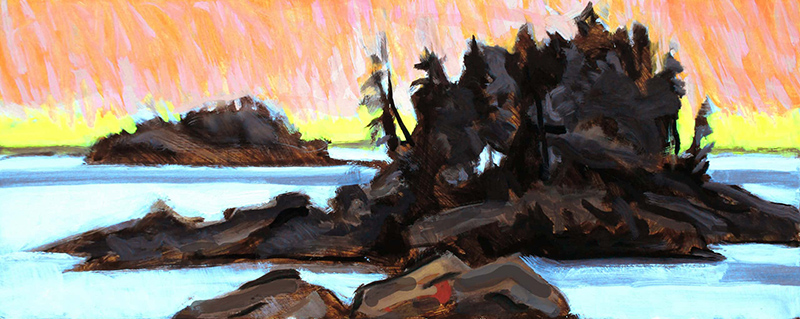
Philip Koch, Maine Islands, 2021, oil on panel, 7 x 17½”. In a few instances, a preliminary vine charcoal and pastel study accompanies the finished painting. In both soft pastel and forthright oil, Maine Islands, 2021, provides a pleasing prospect of a couple of islands, one of them quite scraggly, set against a pinkish sky.
Koch also paints the Maine coast, another classic landscape subject. With its rocky outcroppings Narrow Cove, Ogunquit, 2021, recalls some of Edward Hopper’s paintings made near the same spot (his Sea at Ogunquit, 1914, was reproduced on a U.S. postage stamp). The aesthetic lineage makes sense: Koch has been artist in residence at Hopper’s Truro home and studio 17 times.
In a statement for Isle of Dreams, the painter acknowledges his admiration for Thomas Cole and other 19th-century American landscape painters, in particular their “whole-hearted celebration of a natural world.” Ascension, 2022, and The Voyage of Memory, 2004, bring to mind Cole’s transcendent vision, rendered in contemporary terms that include a bold palette and lively brushwork. In these paintings and others, Koch offers a dream-like Maine, an invitation to new worlds where meandering estuaries lead to the sea and a sailboat makes its way through a northern wonderland.
—Carl Little
- AS ABOVE, SO BELOW
World’s Fair Gallery • Providence, RI • worldsfairgallery.com • Through August 26, 2022
World’s Fair Gallery strongly adheres to the principal that art is meant to be lived with and in. Each show is paired with ceramic and glass vessels, enhancing accessibility to the artwork itself. The gallery’s owner and curator, Willa Van Nostrand, notes the importance of experiencing art in many media, commenting, “Our sensory intelligence is activated when we touch and experience things in person…. It accesses a different plane of artmaking and experiencing.” This is evident in the gallery’s most recent exhibition.
As Above, So Below is a three-person interdisciplinary show rooted in explorations of color, transparency, and physical objectivity. Centered around Brett Day Windham’s hand painted cyanotypes, the show expands into the air in blown glassware by Pierre Bowring, and grounds itself in the earthenware vessels of Tammy Kim.
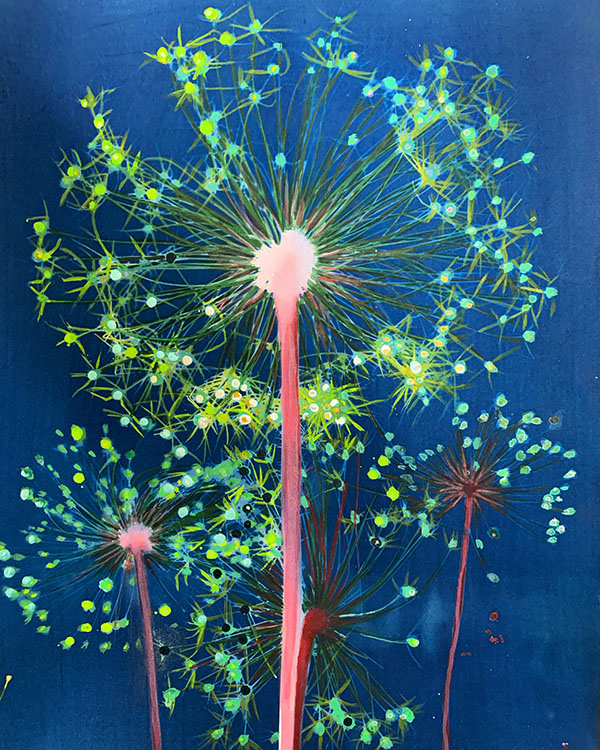
Brett Day Windham, Fever Dream, 2022, cyanotype, watercolor, gouache, and ink on Fabriano paper, 12 x 15″. Fever Dream is a cyanotype and watercolor painting by Windham that encapsulates the tension between objects and abstraction explored throughout the show. This intimate painting evokes fireworks, as neon green allium flowers explode above pale red stems. The essence of the flower itself remains in almost scientific detail caught by the cyanotype, yet in her use of color and mark-making, the flower is resurrected in luminous memory. Each one of Windham’s prismatic paintings float light and airy within the deep Prussian blue cyanotype, depicting collections of shells, feathers, bones, and snakeskins.
The colorful airiness of Windham’s work is reflected in Bowring’s flamboyant and painterly blown glass vessels. Commissioned specifically for this show, the series of bedside decanters and glassware feature colored “brush strokes,” reminiscent of amoeba and jellyfish caught in clear drinking cups. Enhanced through dramatic combinations of rosey pink, viridian green, and other intense color pairings, these vessels create the sky to Windham’s body.
Finally, the exhibition is grounded in Kim’s ceramic work. Her series Earthen Bodies could be planted and grown. They are earthy and tactile, bubbling out of primordial forms and transforming into mature vessels. In contrast to the glasswork of Bowring, Kim’s earthenware brings us back to the mud and provides the gravity that harkens back to the rich ground of the cyanotype.
—Eleanor Q. C. Olson - ONE RIVER, MANY VIEWS
The Saint-Gaudens Memorial • Cornish, NH • saint-gaudens.org • July 23–October 30, 2022
What does the Connecticut River look like to you? It probably depends on the time of day, your vantage point, your culture, even your past experience. In One River, Many Views, three artists respond to the river’s beauty, power, and cultural history, at times using the river water, its soil, and its flora as part of their artmaking process. The exhibit is on view at the Saint-Gaudens Memorial, founded in 1919 to preserve and exhibit the home, studios, collection, and gardens of sculptor Augustus Saint-Gaudens.
When you enter the Picture Gallery, the first objects that strike your eye are two up-ended, 9-foot tall, boat-like structures created by Massachusetts artist Nancy Diessner. The translucent paper shapes of the boats are cast from an old rowing scull, and contain landscape images made by dipping sheets of Japanese paper into the pollen floating on the river. Diessner also displays photography etchings which “go beyond the surface to see the river in a completely un-riverlike way. It’s not about one spot on the river,” she says, “but about the river’s movement and energy.”
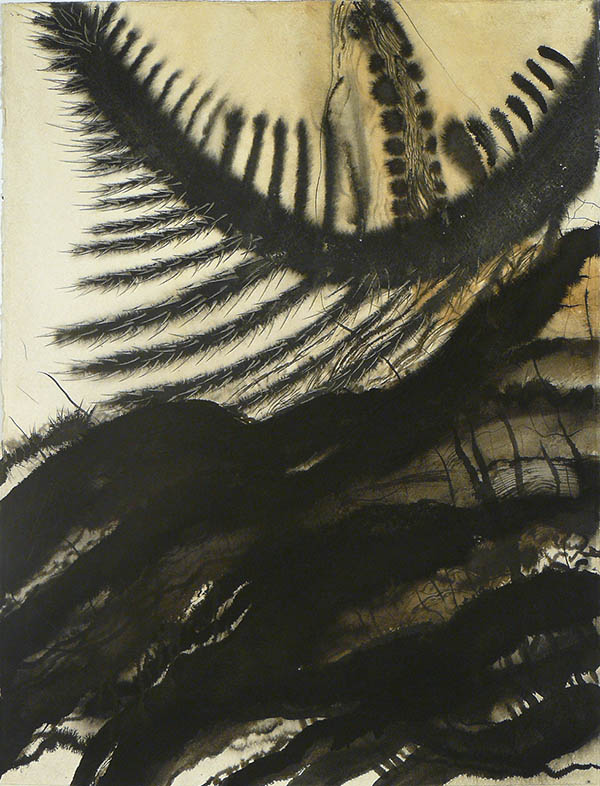
Brenda Garand, Deluge, 2014–16, India and walnut ink, flood clay, 30 x 22″. Dartmouth professor Brenda Garand’s series, Deluge, is drawn from her experience of Tropical Storm Irene, which flooded her studio in 2011. She compares a visual recording with oral history: “Both are interpretations of events. Each place on the river is unique and contains the feeling and history of that place,” she says.
Janet Pritchard, a landscape photographer who teaches at the University of Connecticut, documents the river using a method she calls historical empathy, focusing on the intersection of nature and culture and drawing on research and archival materials to guide her process.
The exhibit also features wall texts by Upper Connecticut River Valley residents, including members of the Indigenous, agricultural, and recreational communities. Concerns about the changing environment are present in the works, says trustee Inez McDermott, with each artist expressing their ideas in vastly different ways and with different materials.
There is much to see, including sculpture-filled gardens and glimpses into the life of Saint-Gaudens and the Cornish Art Colony. And of course,
you may enjoy many Connecticut River views of your own.—Laurie D. Morrissey
- Roberto Visani: Form/Reform
Brattleboro Museum and Art Center • Brattleboro, VT • brattleboromuseum.org • Through June 12, 2022

Roberto Visani, cardboard slave kit, abolitionist blend (2020), cardboard, numbered open edition, assembled object dimensions: 72 x 68 x 53″, kit dimensions: 9 x 43 x 32″. This prescient, powerful exhibit is installed in the Wolf Kahn and Emily Mason Gallery, as well as on the Stage. The historical referents are key in relation to the Black Lives Matter movement and bring the viewer back in time to when slavery was an established fact of life in the U.S. as well as other places in the world, and reminds us of the continuing implications for people of color and for society.
Sculptor Roberto Visani researches art historical depictions of enslaved people, and through the use of digital modeling and laser-cut cardboard segments, constructs a contemporary reinterpretation of a well-known predecessor. Visani also offers these for sale as cardboard slave kits that can be assembled with a hot glue gun. He sees these as an invitation to be part of the creation in the manner of Joseph Beuys’ “social sculpture.”
Because of the blend of representation and abstraction, they are even more mesmerizing. Cardboard slave kit, abolitionist blend 2020, is based on the seal of the Society for Effecting the Abolition of the Slave Trade created in 1787. The sculpture of the enchained, kneeling African man beseeching us “Am I not a Man and a Brother” is haunting.
Each form stands out in a constantly changing silhouette against the wide, white walls, punctuated by sparsely spaced drawings in antique frames. Cardboard slave kit, bussa blend 2021, is based on the Emancipation Statue, a public sculpture located on Barbados. Bussa is the slave who helped inspire a revolt against slavery on the island in 1816. It is displayed on the central stage and its stance is even more powerful than the original.
Cardboard slave kit, carpeaux blend 2021, is based on Pourquoi! Naitre Esclave! (Why! Born Enslaved!), created by Jean-Baptiste Carpeaux in 1868. The portrait bust with her full head of hair and determined, resistant look was originally conceived as an allegory of Africa, and seems to be saying “born into slavery, but not reduced to slavery!” Visani has created sculpture that is absolutely unique—and even more powerful because of its potent evocation of the past relating to the present.
—B. Amore
- Re-Examining Conservation: Questions at the Intersection of the Arts & Sciences
Brown University, Granoff Center for the Creative Arts • Providence, RI • creatureconserve.com • Through June 10, 2022
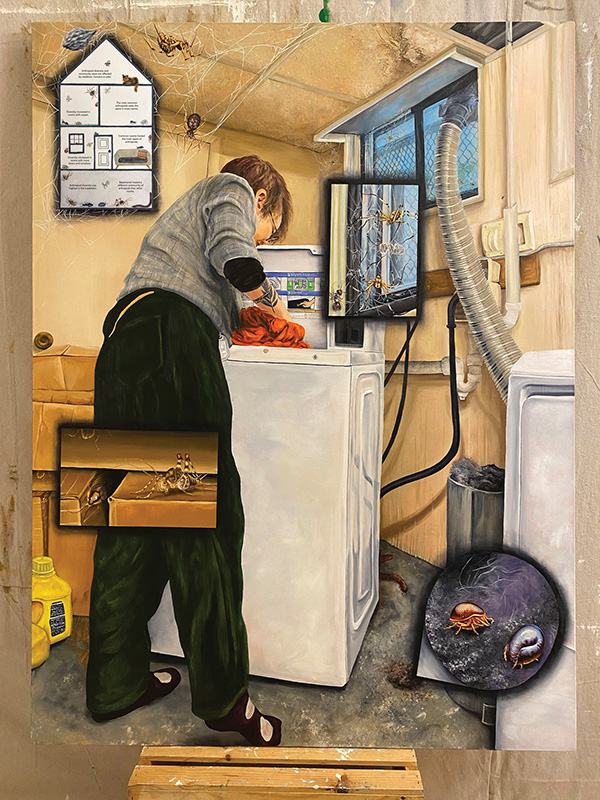
Eleanor Q. C. Olson, Basement Buds, 2021, oil on board, 48 x 36″. Courtesy of the artist. Like all of this writer’s favorite exhibitions lately, Re-Examining Conservation starts with questions rather than proclamations. Curated by Heather McMordie with support from curatorial scholars Haley Johnson (Mashpee Wampanoag) and Lynsea Montanari (Narragansett), this is the first of Creature Conserve’s three exhibitions aimed at restructuring (re-examining, re-imagining, and re-populating) our relationship with conservation. Among the sculptures, paintings, poetry, and video installations, the exhibition pushes us to reconsider “What is conservation?”
In the spirit of this exploratory reevaluation of a familiar topic, the media and approaches to the topic range from the acute to the referential. All artists were tasked with the challenge of visualizing the dynamics between human and animals. Duncan Berry’s ethereal Sitka Salmon (2022) illustrates the intertwined relationship of the Sitka spruce trees that receive an annual boost of much needed nutrients from the Chinook salmon’s decay after spawning season comes to an end. The salmon’s silhouette is achieved through an original impression of the spruce’s rings, linking the deep sea with the arboreal. Carina Cheung’s elegant and impossibly delicate blown glass sculptures of animal and plant forms speak to the fragility of increasingly endangered creatures and environments. As glass is a particularly environmentally-taxing medium, her tender works make clear how enmeshed we are in questions of conservation. Similarly, Eleanor Q. C. Olson’s charmingly familiar Basement Buds illuminates the many (and many-legged) friends that we cohabitate with, whether or not we’re aware of it. The robust selection of works vary widely in their answer to the curators questions; from addressing the shifting landscape to how we’re never far away (nor even distinct from) “nature.”
In addition to the exhibition’s unfolding across the Cohen and Atrium galleries, there is also a Book-Based Interactive Installation with an invitation to read, respond to, and write your own stories based on the queries of Creature Conserve’s exhibition. There is a collection of books aimed at all ages as well as prompts for kids to engage. This thoughtful level of interaction, coupled with scheduled symposia and workshops, voices the spirit of the larger project, that together “we have the power to shape conservation into a practice that is more accessible, meaningful, and relevant to all.”
—Elizabeth Maynard
- MacRae Wylde: Truth
Nesto Gallery at Milton Academy • Milton, MA • milton.edu/arts/nesto-gallery • Through June 18, 2022

MacRae Wylde, Truth cubes installed at Milton Academy. Outside of Nesto Art Gallery at Milton Academy there is an exhibit by MacRae Wylde entitled TRUTH. Set back from the street with five panels of hand-crafted iron work, each displaying a single letter that spells out the word. From a distance, the letters seem to hover above the ground, yet to step closer is to see the irony of its position. The concrete wall that sits behind the exhibit has numerous, small indentations in the concrete, varying sizes as though the word truth itself had been peppered with some projectile response. Yet each letter of the word remains inviolate.
Inside Nesto Gallery stands Wylde’s second piece, child-like blocks fill the space, stacked one on top of the other. Each of the five, 18-inch metal blocks look like they have been heaped skyward as if Wylde was playing with innocence. The letters on each side spelling out four words: truth, honor, trust and faith.
“Truth doesn’t care what party you’re affiliated with, it doesn’t care who your parents are or who you love, it’s there. It’s not convenient but it’s there. We as a society have forgotten that truth is a starting point, not to be bent to one person’s agenda,” writes Wylde in text accompanying the exhibit.
Wylde began his anthology with Truth in 2019, creating a series of three separate exhibits that have crossed the country through shifting landscapes and audiences. This third exhibit has landed at Milton Academy, a fitting hamlet for TRUTH (and truth) to rest, in the halls of our future intermediaries.
Ian Torney, executive director and visual arts chair, has captured his students’ voices in several ways. Three life-sized, faceless papier-mâché bodies sit across from the sculpture caught in a perpetual angst and contemplation as if pondering the meaning of Wylde’s creation, while creative writing students have contributed essays with their personal experiences with truth.
“Most people view public art as an obstacle to move around,” says Torney. “The trick is to make something interesting, so that you pause to contemplate what’s there.”
Nesto Gallery is open to the public by appointment only at nesto_director@milton.edu.
—Maureen Canney
- Craig Stockwell: memorials (observed)
Jaffrey Civic Center • Jaffrey, NH • jaffreyciviccenter.com • Through June 4, 2022
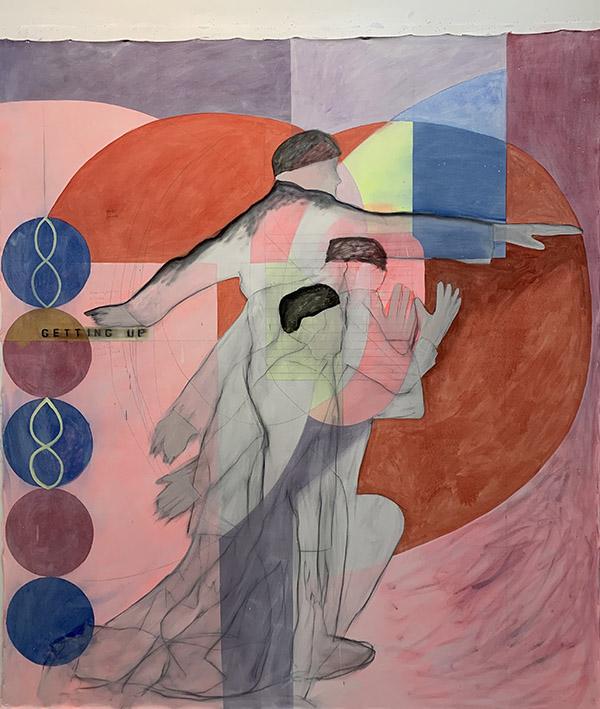
Craig Stockwell, Getting Up, 2021, oil on canvas, 83 x 73″. When this writer first saw Craig Stockwell’s work years ago, it was filled with curving, amoeba-like shapes: an influence of Miro and Gorky yet uniquely interpreted. Since then, his work has evolved to include layered forms with implicit figures, with much of the recent work affected by Covid-19. The Jaffrey Civic Center is the first to exhibit his powerful series of large memorials (observed).
John’s Body from 2021 doesn’t actually show a figure, though that will evolve in the next few paintings. Here the amoeba-like shapes have been contained in a tangle of floating forms in pink and green, connected by a yellow line winding through at least two layers of space. Stockwell’s work is richly painted, and the colors are sensuous and warm, even the greens.
In Naked, beneath the green wobbly shapes in the foreground, the pink coalesces into the back of a standing nude male with outstretched hands. Is this a call for order? Do the “amoeba” forms represent germs? As is often true of abstraction, forms can resonate with multiple meanings.
In this series, Stockwell moves from painting to painting, evolving the spatial layering and symbolism with each work. In a few of these, we observe overlapping figures that are “rising” or “falling.” In Falling, three figures in a light gray-brown, fall forward ahead of a darker, mysterious figure in the background. This is followed in the next painting with figures “getting up” against a background of pink and red abstracted circles. Two of the blue circles have lighter infinity shapes. Does this suggest an eternal hope of rising from difficult times?
Stockwell uses color and form beautifully. Smaller canvases sometimes embellish the sides of larger works, as in Dickenson, with purple and lace, and Gustav Carlson, with gridded lines in green and blue, a narrative of the frozen death of his great-grandfather in 1909.
There are other, smaller, and more geometric paintings scattered through the Cunningham Galleries of the JCC. In these, Stockwell plays with hard edges versus more painterly bursts of color: a contrast of intellect, perhaps, against emotions. These are exciting paintings that connect a fluid geometry with figures reaching out to establish themselves in the unknown. Even as the fear and mysteries of Covid-19 wane, these paintings offer hope to those humans reaching out.
—Susan Wadsworth
- Pell Lucy: In Praise of Form
Piano Craft Gallery • Boston, MA • pianocraftgallery.com • April 1–24, 2022
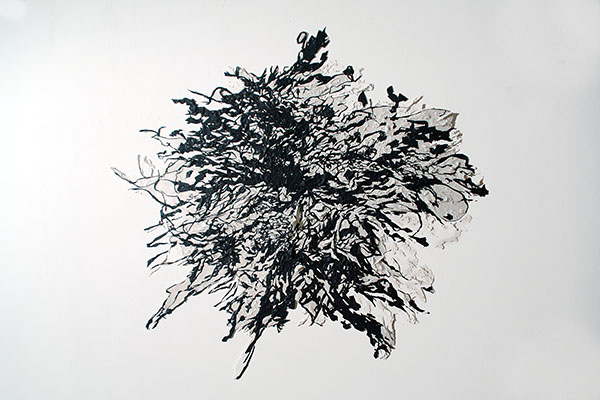
Debra Weisberg, Conundrum, black and white paper tape on paper, 78 x 81″. In Praise of Form fills the Piano Craft Gallery with a resonant luminescence. Pell Lucy is an international collective initiated by Deborah Barlow in 2019 and developed throughout the pandemic. It has held seven virtual exhibits. This is the first in-person presentation of an impressive array of highly developed artists.
Barlow explains that the name is a variation of the word, “pellucid” which implies clarity, seeing through to something else. “Pell” refers to a manuscript on parchment—an artifact. “Lucy” derives from Lucien, which infers light. In contrast to post-modernism’s prioritization of issues and ideas, Pell Lucy’s artists concentrate on form rooted in an ecological ethos that emphasizes the interrelatedness of all things.
Silver Web, by Joanne Lefrak, is inspired by spiderwebs in ancient Nepalese monasteries, and by topography. Using silver on glass, she explores the mystical power of patterns and visual forms drawn from nature. Karen Fitzgerald’s Fog Light (Remembering Gay), an unusual combination of Venetian plaster, mica, Yupo paper, and gold leaf, looks like two, almost transparent, floating icebergs in a band of mist. Fitzgerald’s search to bring matter and spirit together has resulted in a mysterious and evocative piece.
Debra Weisberg’s Conundrum utilizes black and white paper tape to create a portrait of the artist’s journey in search of a final form. Weisberg sees her constant re-adjustments, additions, and subtractions as parallel to nature’s continuous re-shaping of landscape. Sailing Away, Paula Overbay’s tour de force painting composed entirely of dots, carries the viewer into infinite space. Likewise, Barlow’s Kasetti 2, and Tina Feingold’s Rapture, are open-ended meditations on the cosmos.
Emissary, an intentionally enigmatic piece by Diane McGregor, uses fragments of text layered with wax and oil paint. The poetic and evocative aspect of these snippets creates a fascinating alchemy. It’s a symbol of the exhibition that collectively asks questions about ourselves, our connections to each other, and to nature. There are no “answers” proffered, only “traces,” as it were, of the artists’ courageous journeys into the unknown and back.
The exhibit is accompanied by a catalogue designed by Denise D. Manseau with an essay by Taney Roniger, and eloquent statements by each artist.
—B. Amore
- Human/Nature
Alice Gauvin Gallery • Portland, ME • alicegauvingallery.com • Through March 26, 2022
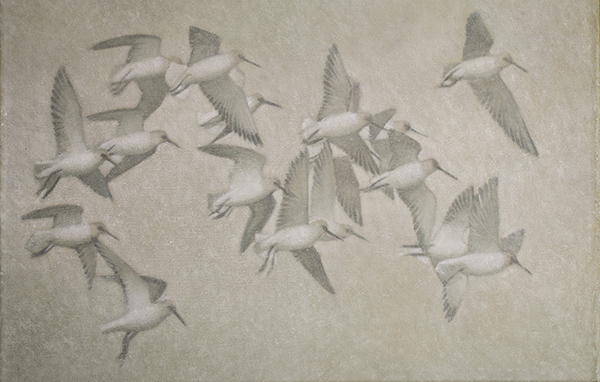
Gina Sawin, Airborne Godwits, 2021, oil on canvas, 18 x 28″. Courtesy of Alice Gauvin Gallery. Opened in 2021, the Alice Gauvin Gallery has gone the group show route for its first few exhibitions, gathering diverse artists around a theme. For Human/Nature, the gallery offers recent paintings and prints by Simon Carr, Cathy Diamond, Elizabeth Higgins, and Gina Sawin, all of whom connect in diverse ways to the natural world through their work.
Based in New Gloucester, ME, Sawin makes her connection via a variety of birds, often presented in groups in flight. An oil, Airborne Godwits, 2021, depicts 16 of the long-billed and -legged migratory seabirds winging across the canvas. This is not the choreography of a murmuration, but rather a kind of stop-action image of helter-skelter avian grace.
Canadian-born painter and printmaker Elizabeth Higgins, who lives in Connecticut, takes a semi-abstract approach to landscape. A 2016 view of Bantry Bay in Ireland is a simple arrangement of hills, sea, and sky, with luminous greens and blues predominant. If not for dark outlines and a small house in the foreground, the painting could be labeled color field. Figure by Shore, 2020, is more emotionally resonant thanks to the small individual in green jacket standing alone before a broad vista.
Queens, NY, resident Cathy Diamond likes her nature all shook up, as it were, with hinted-at plant and what she has called “creatural” forms morphing across the picture plane. The oil on paper Toward the Light, 2022, might be a view through a jungle or an underwater grotto. In the Thick is even more immersive—as if we were in the middle of a winter storm in the mountains.
In his etching and dry proof Lascaux III, 2021, Simon Carr looks back to the Paleolithic cave paintings in southwestern France for inspiration. Carr, who maintains a studio in New York City, emulates the simple majesty of those early images of animals. His active mark-making captures the dynamic of a bucking swayback horse-like creature.
On the basis of this exhibition, the gallery is off to a strong start, presenting four established artists with distinctly modernist sensibilities. Variety, they say, is the spice of life, and this exhibition proves it.
—Carl Little
- SOO RYE YOO RETROSPECTIVE
Soo Rye Art Gallery • Rye, NH • sooryeartgallery.com • January 25–April 25, 2022
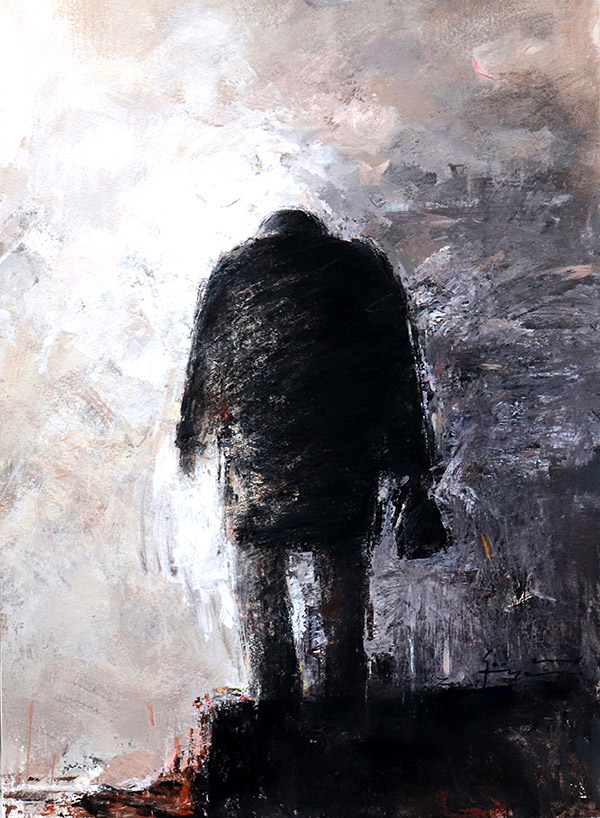
Soo Rye Yoo, Walk Home II, acrylic on watercolor paper. The artist Soo Rye Yoo clearly loves the act of exploration when she paints. Energetic, swirling movement along with the use of different media fuels her paintings’ activity. Whether it be a riot of tiny houses piled on top of one another, or a row of diminutive houses on a distant shore, her work merges abstract expressionism with figuration. Boats at sea, cardinals on snow-laden branches, a man with a bird perched on his hat; there is whimsy and brightness in Yoo’s work. Even in her darker paintings, light shines through as a reflection on water, or a lighthouse gleaming on a faraway rocky shore.
In Walk Home II, acrylic on watercolor paper, a man with his back to the viewer stands hunched over, wearing a long overcoat and carrying a bag. All around is thickly blended black, white, and red, producing a mauve mood of somber despair. This, contrasted with Yoo’s vibrant Dream Bird Time to Soar, acrylic and mixed media on linen, reveals the freedom she allows herself as she plays and experiments with her mediums. The tender and delicate Moon Village series is about small-town life in Korea. She also creates large outdoor sculptures using found objects.
A prolific artist, Yoo founded her art gallery in Rye, NH in 2009. Since then, she has showcased local and international artists, as well as her own mixed media work. Painting since the age of 14, Yoo went to an arts high school and then on to college in Seoul, South Korea. She came to the States to study at the New Hampshire Institute of Art in Manchester, NH, for a BFA in painting. Besides running her gallery, along with director David Christopher, Yoo also teaches art to small groups in a separate studio, as well as private classes.
The retrospective of Soo Rye Yoo’s work spanning 40 years displays an undaunted probing into what different combinations of medium can do. She uses round, square, rectangular, and triangular canvases, moving easily between oil and acrylic paint; bold cadmium orange and red, deep cerulean blue. One can imagine Yoo in her studio, dancing with her brushes and paint, enjoying every energetic moment of creation.
—Dian Parker - REMIXING THE HALL: WCMA’S COLLECTION IN PERPETUAL TRANSITION
Williams College Museum of Art • Williamstown, MA • artmuseum.williams.edu • Through June, 2022
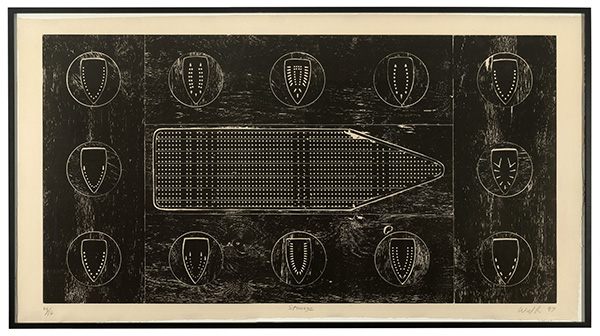
Willie Cole (1955), Stowage, 1997, woodcut on paper. Museum purchase, Kathryn Hurd Fund. Courtesy of the artist. ©Willie Cole. A trio of Williams College Museum of Art curators have collaborated closely to mine the museum’s encyclopedic collection to “remix” objects and their narratives—in a time of public health, social, and political challenges. Without direct access to the actual objects, Elizabeth Sandoval, Kevin Murphy and Horace Ballard (recently appointed associate curator of American art, Harvard Art Museums) have assembled a mind-tingling exhibition, Remixing the Hall: WCMA’s Collection in Perpetual Transition that displays a disparate yet representative array of objects in dialog with each other.
Cutting across place and time, culture and genre, the objects are loosely grouped under the overlapping themes of the visualization of power, transcendent states, the enduring sublimity of water, and hybridity. Since the exhibition centers around multiculturalism, it also advances the social justice actions delineated in the museum’s DEI (Diversity, Equity, Inclusion) Plan 2021–2023, implemented earlier this year.
For example, one wall devoted to a handful of evocations of the Madonna, a divine figure of transcendence, ranges from The Immaculate Conception, a 17th-century Spanish painting attributed to Juan de Sevilla, with its heavenly Mary encircled by angels, to Aminah Robinson’s Oh Mary, Don’t You Weep (1978), depicting a weary and worn Mary and the scrawled lyrics of an African-American spiritual.
One display features devotional objects from several religious traditions—Hinduism, Buddhism, Islam, Christianity and ancient Egyptian beliefs—used to instill transcendent states among the faithful. A 20th-century Qur’an Prayer Board stands alongside a 15th-century Christian Book of Hours. A small, gold Isis figure warded off evil and a bronze statuette of a Crowned Falcon signaled devotion and gratitude.
In the room devoted to the “sublimity of water” (to political philosopher Edmund Burke, “sublime” connoted terrifying experiences), William Morris Hunt’s painting takes onlookers to the dangerous edge of Niagara Falls. Yet it’s Willie Cole’s large woodcut Stowage (1997), which recalls the horrific trafficking of enslaved Africans, that presides over the space and resonates into our contested present.
The curators have chosen not to dictate the exhibition experience, presenting a loose interpretive framework. Thus, visitors have the opportunity to create meaning out of Remixing for themselves. The exhibition’s takeaway is the experience itself.
—Jack Curtis
- There Is a Woman in Every Color: Black Women in Art
Bowdoin College Museum of Art • Brunswick, ME • bowdoin.edu/art-museum • Through January 30, 2022

Elizabeth Catlett, There is a Woman in Every Color, color linoleum cut, screenprint, and woodcut. Museum Purchase, Lloyd O. Marjorie Strong Coulter Fund, Bowdoin College Museum of Art. ©2021 Catlett Mora Family Trust/Licensed by VAGA at Artists Rights Society (ARS), NY. Photo: Luc Demers. In her lithograph, etching, and chine collé print Blue Plate Special, 1993, Alison Saar riffs on the classic motif of the head of St. John the Baptist on a plate. Exhibition curator Elizabeth S. Humphrey speculates that by Saar’s “coding the decapitated head as African American—through the darkened skin tone and hair style—and the use of the phrase ‘Blue Plate Special’—referencing the low-priced meals available in American diners,” the viewer is “meant to interpret this work as a commentary on the violence and undervaluing of Black people and their bodies.”
Part of the mission of Humphrey’s remarkable exhibition is to highlight the undervaluing of Black women in art. Drawing primarily from the Bowdoin Museum, she highlights both the limited inventory—less than 1% of the permanent collection features Black women—and the power of what is there. The more than 60 artworks, which include paintings, prints, photographs, sculptures, and artist books, covers more than two centuries of Black women artists’ contributions and how they have been represented in art.
The title of the show comes from Elizabeth Catlett’s 1975 color linoleum cut, screenprint, and woodcut There Is a Woman in Every Color. Humphrey ties the positive/negative face of a Black woman and the line of colorful stick figures to Catlett’s call for racial equality.
Visual echoes happen from room to room. One instance: the Kara Walker linoleum cut African/American, 1998 showing a woman falling through space lines up with Julie Mehretu’s four-part multi-color aquatint and spit-bite Myriads, Only by Dark, 2014. Using a cut-out silhouette and abstract markings, respectively, both artists reflect what Mehretu refers to as “self-ethnography.”
Humphrey’s show is part of a needed trend to shine a spotlight on art-historical omissions (see, for example, the new installation at the Met, Before Yesterday We Could Fly: An Afrofuturist Period Room). We have a long way to go to make up for lack of Black representation in our art institutions. This exceptional exhibition helps us get there.
[There Is a Woman in Every Color travels to the El Paso Museum of Art.]
—Carl Little
- SHIRLEY JACKSON WHITAKER: An Artist’s Reflection on African-American Life, Culture, and Trials
Bromer Gallery • Boston, MA • gallery.bromer.com • Through March 18, 2022
The title says it all, yet even that does not prepare the viewer for the rich experience that awaits when visiting the exhibit at the Bromer Gallery, an extension of Bromer Booksellers. The gallery features original art, executed by artists whose work is centered upon the idea of the book as art, often with social justice as a theme.
Ashes to Ashes, Whitakers’s book that chronicles the lives of African Americans who were lynched, sits in a glass case. The hand-bound grey volume is open, showing a portrait of a lynching victim, etched by Shirley Jackson Whitaker. The cover of the book is of hand-tooled and painted leather, carved by the late Winfred Rembert (who passed in April, 2021), himself a survivor of a lynching in the ’60s. Whitaker and Rembert are both from South Georgia and she credits him with influencing her use of color and acknowledging the unique gifts of their southern heritage.
Whitaker interviewed Rembert in her award-winning film, Ashes to Ashes. In the gallery, a 5′ tall broadside of a twisted tree is etched with over 4,000 names of lynching victims researched by scholars Amy Bailey, Stewart Tolnay, and E. M. Beck. The artist worked with Michael Kuch of Double Elephant Press to produce the book and the broadside, which are included in the Library of Congress. Both works bear witness to the painful historical past, and also stand as witness to the scenes of African American life that Whitaker has lovingly and powerfully documented.
Shirley Jackson Whitaker is a rare combination of artist and physician. She learned printmaking from Leonard Baskin and studied medicine at Yale. Portraiture comes naturally to her—and in the exhibit, there is a range of expression, from delicate drawings to bold paintings and carefully rendered etchings. The gallery literally vibrates with the energy of the lives portrayed.
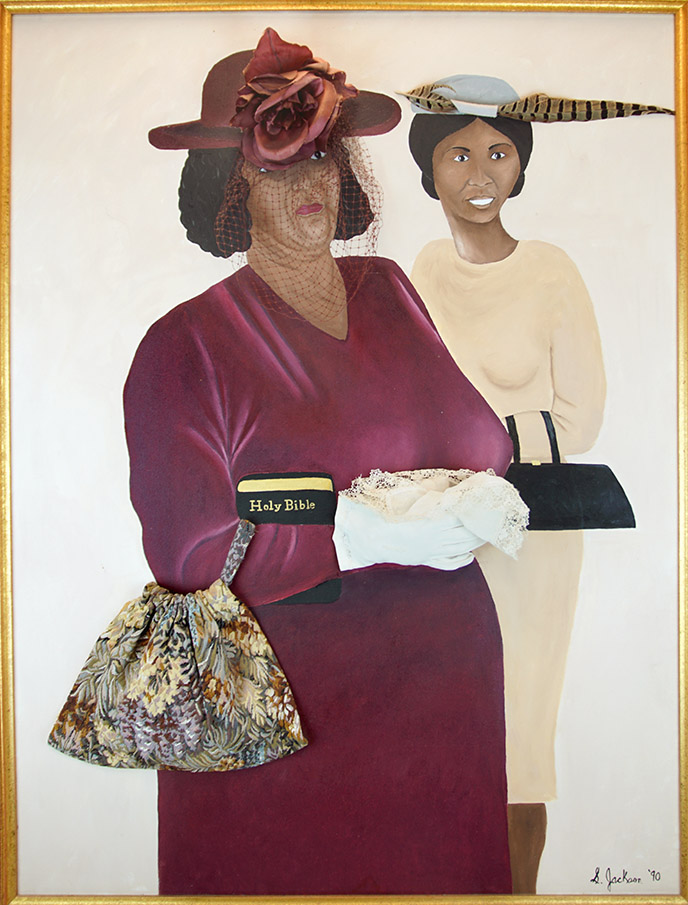
Shirley Jackson Whitaker, Church Ladies, 1990, oil and fabric on canvas, 41 by 31″. Church Ladies is a 45 x 30″ portrait of the remembered women of her youth, in their Sunday dress. Painted in flat, even tones, the women come alive with three-dimensional additions. One sports a rose in her hat, complete with veil. Her white-gloved hand holds a lace handkerchief. A stuffed flower tapestry purse complements the painted gilt-edged bible in the crook of her arm. Both the seriousness and the joy of the Sunday ritual is honored.
The entire exhibit is a celebration of African American life. Although there are etchings of well-known figures like Toni Morrison and Gordon Parks, more often the subjects are not famous. Many are of individuals that Whitaker has met or known personally. In a series of drawings done during Covid, Little Girl with Plaits stands out with her mischievous eyes and broad smile. Her plaits fly out around her head like an energetic aura. Keisha is deeply introspective, with a delicate use of shading from the lightest of greys to black. In contrast to Little Girl’s wild plaits, her braided hair is gathered in a fashionable topknot on her head.
Lady Shelling Peas also has a concentrated interior look as she meditatively goes about her task. Full fields form the backdrop of the painting, which becomes a portrayal of a way of life, lived with decorum and restraint. Shirley Chisholm celebrates a proud, smiling younger Chisholm in a fantastically textured and patterned dress. The thick oil paint looks as if it has been carved, like Rembert’s tooled leather.
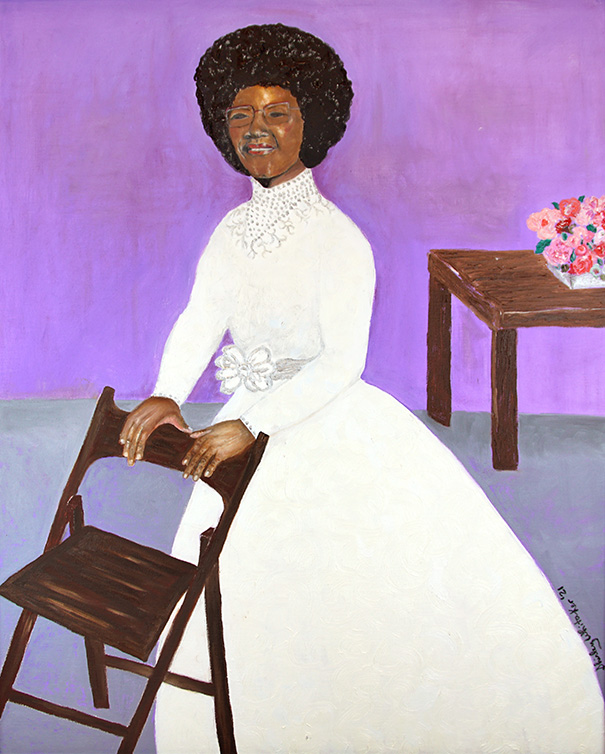
Shirley Jackson Whitaker, Shirley Chisholm, 2021, oil on canvas, 32 by 25½”. The gallery pulsates with energy. The soul of the artist’s sensibility is palpably present. She is a thoughtful observer and celebrates the famous and the ordinary with equal attention and grace, as in the paintings, The Checkerboard Player and a boy’s First Cut. The mood is a celebration of African American life, carrying undertones of a painful history inevitably woven into the whole.
Martin Luther King’s words come to mind, “The arc of the moral universe is long, but it bends towards justice.” This exhibit is prescient in the historic moment in which the Black Lives Matter movement has reaffirmed the necessity of looking into the eye of history to find the insight necessary to inform our present issues. Shirley Jackson Whitaker is willing to take a hard look into the past, and equally willing to celebrate the strength and persistence that African Americans have shown in forging strong community connections which sustain their cultural and spiritual life.
—B. Amore
- Enigmatic Spaces: Mara Metcalf, Kristin Street, and Tina Tryforos
The Chazan Gallery at Wheeler • Providence, RI • chazangallery.org • Through November 10, 2021
Chain link melts into thread as it draws together moments of a just-discernable urban landscape in Mara Metcalf’s Almost Anywhere Stringer, 2021. This making-visible of often unseen or unnoticed liminal spaces is where the work of Metcalf, Kristin Street, and Tina Tryforos overlaps. Though each artist’s technique and point of departure is distinct, all three invite us to consider more closely our relationship to these eponymous enigmatic spaces.
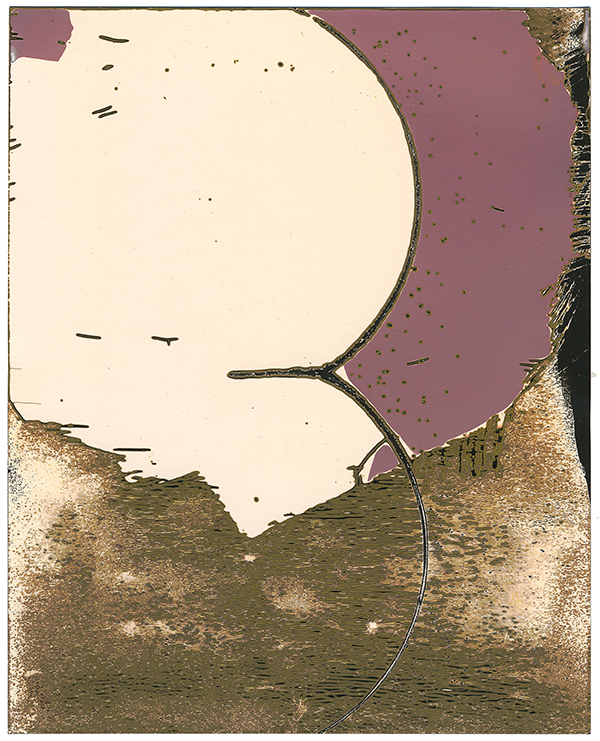
Tina Tryforos, Seagull Warmtone N. Windsor Newton and MSA varnish, 2018, chemigram on fiber base photo paper, 13 x 15″. Photo: Tina Tryforos. When Tryforos was confronted with her cancer diagnosis and subsequent treatment, she began using the photographic process of chemigrams in her prints, often used in medical imaging’s oblique capacity to see into the body. The medical, yet poetic, term “architectural distortion,” a group of cells that doesn’t present as a visible mass and is yet significant, inspired her consideration of the ways we identity and treat disease, “both corporeal and societal.” She works in turns with chemical exposure and etching on varnished photo paper to examine the dynamic of the “natural” world inevitably shaped by human intervention. Indeed the shapes and colors that manifest in her images are completely contingent upon the content of the choice of paper and varnish, as is evident in the titles of prints like Seagullwarmtone N.WN+MSA, 2019. The luminous, abstracted prints present in a beautiful and nuanced array of shifting textures and tones that point to her thoughtful descriptions of the relinquishing of control that can be part of creating and exhibiting abstract forms, let alone enduring opaque and seemingly arbitrary cancer treatment.
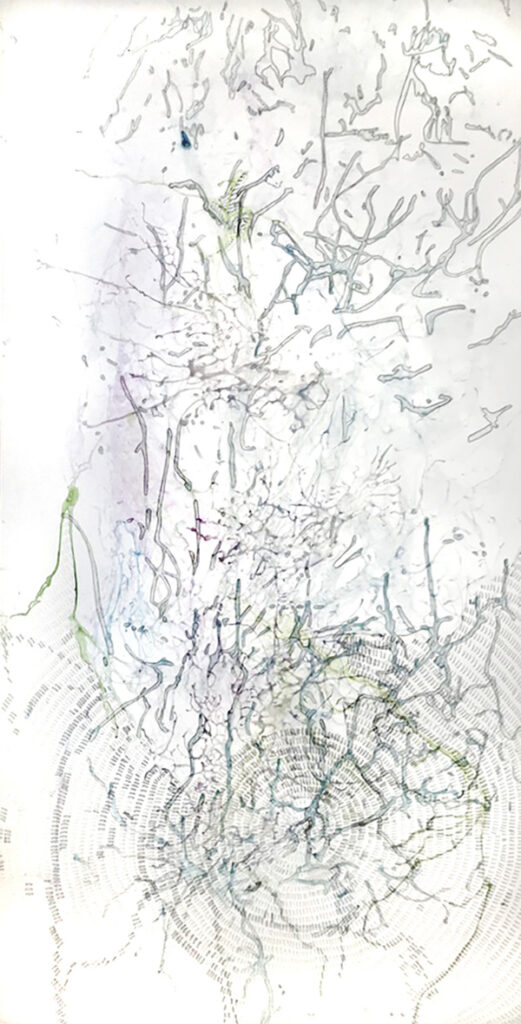
Kristin S. Street, Intermingling, 2021, ink on vellum, 68 x 36″. Photo: Kristin S. Street. This human mediation is also at play in Street’s process-oriented images, as in Interconnections, 2021: one of three large-scale translucent and double-sided works. These larger hanging pieces and her smaller framed drawings simultaneously invite and deter our reading. Their intrinsic depth and dimensionality point to her background as a textile artist. Defying the conventional two-dimensionality of drawing, Street’s exploration begins with and then transcends the illusion of space as she layers marks upon marks, each informing the next in an unfolding of the space: “even if they are ‘only’ lines on paper, every mark depicts a front and back and divides light and dark, figure and ground.” Both the unpredictable yet responsive process of her drawing and her consideration of the migratory patterns of birds give the works a near vibrating quality.

Mara Metcalf, Almost Anywhere Stringer, 2021, collage and thread on paper, 11 x 7″. Photo: Mara Metcalf. Metcalf encourages a similar kind of deep, sensory looking, grounded in her own observation of the natural world. Her meditative walking practice has carried her through life, the Pacific Northwest to New England, and especially during the challenges of COVID. Drawing, she remarks, is all about touching. Her additive process (in some cases collaged xerox transfers, in others she quite literally stitches together the elements of her “drawings”), builds an urban landscape at once distant and familiar. Yet rather than attempting to unravel these liminal moments, she seeks to bring them together, to explore what beauty lives in the imperfection of these oft-overlooked spaces. This quality of bringing together is palpable in the exhibition —there is a lovely resonance that echoes between the three distinctive bodies of works. Each decidedly their own technique, approach, and texture, they nonetheless speak to each other in a mutually illuminating way. Explore what hidden meanings might arise for you in the space between.
– Elizabeth Maynard
- Rhode Island I.M.A.G.I.N.E.S Peace
Bannister Gallery at Rhode Island College • Providence, RI • ric.edu • October 7–29, 2021
In 2019, Bannister Gallery at Rhode Island College (RIC) commissioned a group of 25 metals artists from around the country to utilize decommissioned firearms in artworks and address the polarizing topic of guns with their own techniques and methodologies. This decentralized approach to the “stance” of the exhibition allows the artists to take on an array of voices, thus opening up expressive and engaging discussions and dialogues. The exhibition Rhode Island I.M.A.G.I.N.E.S (Innovative Merger of Art & Guns to Inspire New Expressions) Peace, curated by Boris Bally, Dianne Reilly, Sara Picard, and Victoria Gao, originally scheduled for fall 2020 instead takes place this October, 2021.
The artists’ control over their artistic direction allows the show to come together as a complex web of beliefs, opinions, and discussions. Stefan Gougherty’s work GAME OVER melds the virtual and pixelated world we have become ever more enmeshed in with the physicality of an actual revolver. A masterfully crafted piece, the crossover brings our attention to issues of violence in digital media; as mentioned by Gougherty, “guns have become emojis—lethal weapons are trivialized, and the real-world consequences of pulling the trigger have become abstracted.”

Stefan Gougherty, GAME OVER, 2019, deactivated revolver, stainless steel, industrial paint, 4.5 x 10 x 6.5″. RIC alumni, Lauren DelBrocco’s Curiosity is a different and remarkable approach offering the viewer the unusual occasion to physically engage with the artwork. On the glossy black box housing the object are the engraved words, “[a]n estimated 4.6 million children live in homes with at least one unlocked and loaded gun and most children know where these guns are kept.” Referring to the work, DelBrocco says “Look through the eye lens, down the gun barrel. | Hold the piece up towards the light. | Slide open the aperture lever. | Spin cylinder. | 1 of the 5 cylinder slots is a bullet.” As one holds the work up to the light staring down the barrel it becomes an elegant kaleidoscope.
Without villainizing, blaming, or polarizing, this curation seeks to collect perspectives and complicate discussions on gun ownership and safety—aiming to spark nuanced conversations around the artwork. There is an opening reception on October 7 followed by a panel discussion that is sure to engage and educate.
—Abbi Kenny
- Positions and Props: A Loosening Line
A.P.E. Gallery • Northampton, MA • apearts.org • October 8–November 6, 2021
There is a lyrical connection between the sculpture of Roberly Bell and the paintings of Sandy Litchfield. Their decision to create this exhibit together came out of conversations on long pandemic walks. Throughout a process of sharing haiku texts, snapshots of studio drawings and other studio experiments, they devised a way to distill the unpredictable world into their studio practice. The resultant Positions and Props: a loosening line retains the sense of this open experimental approach.
Litchfield’s canvases and Bell’s forms mirror each other in the flow of form and color. Bell’s sculptures “dance” before the rhythmical patterns of Litchfield’s paintings. The bulbous, upward thrusting forms of Bell’s Foreign Object #31 harmonize with the organic shapes of Litchfield’s Remedy. There is a sense of an undoing of boundaries between two things, like a figure in landscape. The exhibit title suggests a theater set, with props in place. The artists write that “the logic just appeared by itself—a painting and a sculpture in proximate space, each recognizing a part of itself in the other.”
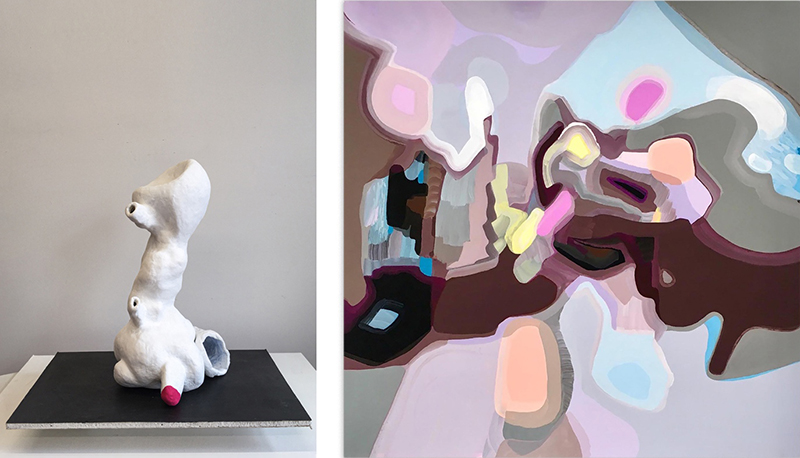
Left: Roberly Bell, Foreign Object #29, plaster, paper clay, flocking, 33 x 15 x 24″. Right: Sandy Litchfield, Wassassne, 2021, gouache on paper, 22 x 22″. Bell’s sculptures in plaster, paper, ceramic, and wood sometimes seem to be a translation of Litchfield’s gouache and oil paintings, even though they were created independent of each other. Litchfield’s Wassassne, a fascinating composition of flowing, interlocking forms in shades of plum and blue, is complemented by Bell’s Foreign Object #29 which looks as if it could have whimsically popped out of the painting.
Available Potential Enterprises, aka A.P.E. Arts, is a Community Arts Trust that supports artists working in all disciplines. It is a perfect venue for the innovative pairing of Bell and Litchfield who explored words like space, landscape, sky, water, earth, light, wind in refining the concept of the show. They both have extensive research and teaching experiences, which provide the formal underpinning of their work. Bell and Litchfield carefully planned and installed this exhibit, which enlarges the scope of their individual disciplines and provides the viewer with a delightful experience of a “loosening line” that embraces both artists’ expressions and creates an experiential environment within the gallery space.
—B. Amore
- Carrie Mae Weems, Robert Gerhardt, and Roberto Lugo
Fairfield University Art Museum • Fairfield, CT • fairfield.edu/museum/ • September 18–December 18, 2021
At Fairfield University Art Museum, the fall kicks off with exhibitions as timely as the changing leaves around us. The museum will feature The Usual Suspects by Carrie Mae Weems, Mic Check by Robert Gerhardt, and New Ceramics by Roberto Lugo, each accompanied by artist talks, film screenings, and lectures in response to the work.
This pairing is intentional given that the work of all three artists teaches us how to correct our gaze using mediums, materials, and techniques that we either ignore or take for granted. For example, the way we ignore how our gaze is directed to viewing the Brown or Black body as criminal; the invisibility of our critique with everyday items like ceramics as conveyers of class and privilege; and the way we may find ourselves surrounded by history in the making to such a degree that we tune it out, figuring that it will soon be written somewhere.
In the case of Weems, her archival pigment prints, silkscreen panels, and video works reposition the Black body, placing it front and center. Blurred images and color blocks strip us of our senses, forcing us to reckon with stereotypes and internalized biases.

Carrie Mae Weems, All the Boys (Profile 1), 2016, archival pigment on gesso board. Courtesy of Jack Shainman Gallery. Commonly shouted during the Black Lives Matter protests as a way of inspiring call and response, Gerhardt’s Mic Check is not just a nifty phrase, but a catalyst and tool. Through his candid black-and-white photographs of protests from 2014–2021, Gerhardt’s work is a passionate call to the viewer to take notice and recognize how history is unfolding before our eyes. Roberto Lugo’s contemporary ceramic pieces and iconography ask readers to reconsider pottery making outside of the Eurocentric gaze. Lugo disrupts the narrative by transforming the surface of porcelain into an altar space, paying homage to faces and bodies who have traditionally not been seen or heard within landscapes reserved for wealth and white skin.
When talking to Gerhardt and Lugo about what viewers can expect from the exhibitions, they shared similar responses that extend beyond the art itself. For Gerhardt, no matter where you sit on the spectrum of the Black Lives Matter movement, he hopes to create a conversation. For Lugo, who grew up not knowing that a career in the arts was possible, let alone working in ceramics, he “hopes that people will see what I do as a form of resourcefulness.” During a period of great social and cultural change in our nation’s history, Weems, Gerhardt, and Lugo invite us to see art, and to play outside of our boundaries.
—Shanta Lee Gander
- Monadnock Art Tour 25th Anniversary
Monadnock Art/Friends of the Dublin Art Colony • Monadnock Region, NH • monadnockart.org/plan-your-tour/ • October 2–30, 2021
Have you ever gone to an exhibition and wish you could talk to the artist? Do you ever wonder what the artist was thinking? Here’s your chance to spend the weekend chatting with 70 different artists in their own studios, all within the Monadnock region. Imagine the crisp air and forested slopes on fire with foliage as you drive from studio to studio, having planned your bespoke route according to your interests, and topping it off with refreshments from a quaint general store or charming restaurant. Welcome to the Monadnock Art Tour (MAT).

Studio of Soosen Dunholter, Peterborough, NH. This is MAT’s 25th anniversary and they’ve planned some special extras. The tour kicks off with an exhibition of representative work from each artist on the tour at the Monadnock Center for History and Culture in Peterborough. On Opening Day, October 2, there’s a free, family-friendly gathering outdoors featuring live music, cider, and donuts followed by the official artists’ reception that evening. At the exhibit, peruse the enlarged map of the all the studios on the tour sprinkled throughout the towns of Dublin, Hancock, Harrisville, Jaffrey, Marlborough, Peterborough, and Sharon. Check out the work, see what interests you, find the studio on the map and plan your route for the weekend.
The studio tour offers dizzying diversity of media, including glassblowing, marquetry, wearable art, weaving, and ceramics, along with painting, collage, photography, and more. After studio hopping, there’s always hiking, biking, and lake fun to be had.
The Monadnock region has the highest concentration of artists in New Hampshire. With Mt. Monadnock as its muse, the art scene first blossomed with the storied Dublin Art Colony, most active from the late 1880s to 1950, and from which the tour takes its inspiration. Abbott Thayer (1849–1921), a nationally prominent painter who settled his family on Dublin Lake, was the eccentric mentor and magnet for a group that gathered around him, and many attained their own fame. They include George de Forest Brush, Barry Faulkner, Frank Weston Benton, and Rockwell Kent, among others. In honor of this rich heritage and the 25th anniversary of the tour, the MCHC is holding a concurrent exhibition of the Dublin Art Colony artists.
—April Claggett
- Life Streams: Alberto Rey, Cuban-American Artist
Ogunquit Museum of American Art • Ogunquit, ME • ogunquitmuseum.org • July 30–October 31, 2021
Organized by the Burchfield Penney Art Center, this exhibition offers a mini-retrospective of the painter, videographer, and fisherman Alberto Rey. From the abstract-conceptual Through Windows, 1988, which Rey made in graduate school at the University of Buffalo, to the realist Lost Beauty: Icebergs XVI, from the 2020 series that features renderings of remnants of the Breiđamerkurjökull glacier in Iceland, Life Streams traces Rey’s artistic evolution.
Rey works in series and the show includes a sampling from several. Many address his cultural identity: Born in Cuba, he moved to Mexico at age three and then to Miami and finally to Barnesboro, PA. His Cuban roots tug hardest and are referenced in such pieces as House of Memories and La Basilica from 1991.
Other work conjures Rey’s early life in Miami, in what is now Little Havana. Icon Series: Bag of Chicharrones (Pork Rinds), 1995, depicts the treat his mother would buy him, in all its creased and greasy glory. The artist chose a traditional “high art” format—plaster on a fresco-like support system—to present this humble subject.

Alberto Rey (b. 1960), Las Balsa (The Rafts) Artifacts: Child’s Hat and Seat, 1996, oils on wood filler over wood, 8 x 10 x 4½”. Courtesy of the Burchfield Penney Art Center at SUNY Buffalo State. Image courtesy of the artist. The Las Balsa (The Rafts) series, 1995–1999, drew on Rey’s visits to the Cuban Refugee Center on Stock Island where he found remnants of the perilous voyages people made fleeing Cuba. Las Balsa (The Rafts) Artifacts: Child’s Hat and Seat, 1996, is especially resonant.
Rey’s ongoing Biological Regionalism and Aesthetics of Death series begun in the 2000s reflect on the fate of fish through images of salmon, steelhead, and other species in parts of the U.S., Iceland, Wales, and Cuba. As a professional fly-fisherman, Rey feels a special passion for these creatures and the environmental challenges they face.The exhibition includes three documentary videos: An Unkept Promise (2005), which reflects on the joy and anxiety of Rey’s first trip to Cuba in 35 years; Biological Regionalism: Atlantic Cod, Salem, MA (2007), which documents the history of the New England cod fishery made during his residency at the Peabody Essex Museum; and Bagmati (2016), a look at life along Nepal’s most sacred and most polluted river. All of Rey’s work manages to engage the eye while raising awareness. These are brilliant and commendable acts of art.
—Carl Little
- When the Colors Fade: A Queer Riot Against Corporate Pride
The Queer Art Collective • Pawtucket, RI • thequeerartcollective.org • July 6–October 5, 2021
The Queer Art Collective (QAC) is one of the most recent additions to the Rhode Island art scene, opening their inaugural exhibition this past March in the Pawtucket Armory. QAC is a space devoted to highlighting, supporting, and sharing the works and stories of queer artists. It’s newest show When the Colors Fade: A Queer Riot Against Corporate Pride, brings together six artists from the United States and Canada to explore the ways capitalism and corporations have been deleterious to queer culture. Artists Nicole MelNicky, Lauren Packard, Joe Welch, T. Taumanu, Becka Shertzer, and Alice Kay Waller, working in installation, painting, and ceramics, bring a multifaceted approach to the unique location.
A significant feature of the show is Alice Kay Waller’s continuation of the /200 project. She has previously presented iterations of it in Winston Salem, West Palm Beach, Indianapolis, and Chattanooga. In this project, she has been casting bodies of survivors of sexual assault and using them to build formidable remembrances. By offering open castings to local survivors, Waller aims to support them in the reclamation of their bodies and the battle against assault. En masse, these casts are a bulwark of intimate encounters between artist, survivor, and viewer that are as beautiful as they are poignant.
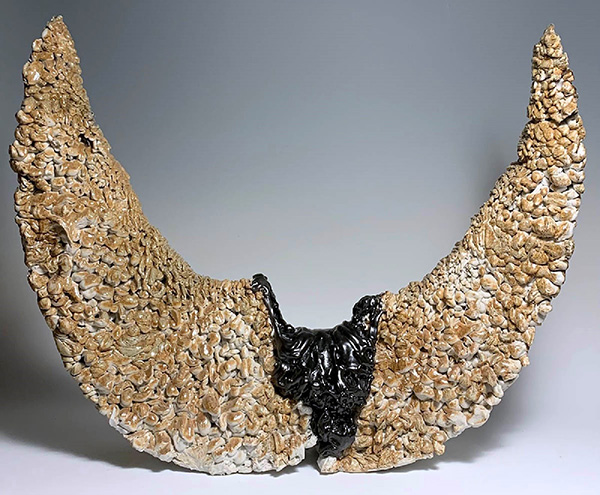
Joe Welch, Schism. QAC has brought together an ambitious selection of artists working with distinguished tactility. Lauren Packard’s expressive mixed media abstractions play nicely against Joe Welch’s hand crafted ceramic sculptures. Packard, a Brooklyn-based artist, explores memories of queerness and fights against trauma related to heteronormativity in her work. Such as in Armor Dyke Honor, which is included in the exhibition. Welch’s piece Schism stands opposite Waller’s installation—hand and body are embedded throughout the space. This exhibition combats issues regarding queerness in a heteronormative culture with the physicality of lived experience ever-present.
This second exhibition at QAC will remain installed through October 5 and will include various programmings such as pop-ups and possible concert series. The gallery also contains a small shop with works available by several U.S.-based and international artists.
—Abbi Kenny
- James Paradis: Meditation on Form and Gesture
Jane Deering Gallery • Gloucester, MA • janedeeringgallery.com • Through July 31, 2021
James Paradis proves that abstract painting is alive and well—and not always two dimensional. Paradis’s solo show at the Jane Deering Gallery in Gloucester captures an art career that began relatively late in life—Paradis completed his BFA at Mass College of Art in his early 70s—yet his work reflects a fully realized aesthetic that spans the nearly two decades since. Paradis’s works strike both gestural and meditative notes (as the exhibition title suggests) while affirming something deeply primal about the way humans communicate through image.
As is often the case with art, Paradis’s sculptured paintings were initially the result of an accident: a frustrated moment in the studio that resulted in a balled-up sheet of paper unfurled and push-pinned to the wall, its newly revealed contours revealing other possibilities. Paradis pursued this “shaped canvas” approach to fruitful ends while continuing to explore the flat canvas.
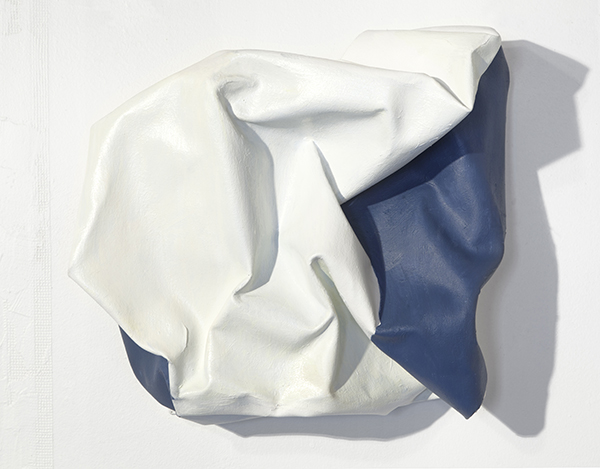
James Paradis, Into the Blue, 2018, oil on sculptured canvas, 12 x 14 x 6″. Courtesy Jane Deering Gallery. Among the more sensual of the shaped works is Cloud 9 (2016, oil on sculptured canvas), a curvaceous and yes, as the name suggests, billowing, even undulating, sculptured painting. The piece simultaneously conjures marshmallows, rumpled bed sheets, and, of course, clouds. Its white hues are both subtle and complex with the emergent contours and shadows adding even more depth. A nearly indiscernible light blue seems to whisper from beneath to suggest clouds floating in the sky, viewed from an airplane window looking down. Paradis’s flat canvases are also, in many cases, nearly monochromatic, yet stop short of color field; and many of the paintings are textured, moving into space as if reaching out to the sculptured works. In both cases, abstraction dances with image: figures, walls, faces; water, sky, earth.
There’s gesture, there’s color, and there’s three-dimensionality, in all cases paying homage—whether to a single color (say yellow, blue, or green) or aesthetic idea, and always conveying a delightful ephemerality: A face emerging from an amber-hued color field, a ghost-like apparition in the shadows of a wall, an ocean with primordial beginnings foreshadowed in tiny points of light. As Paradis puts it, “for out of nothing rebirth and renewal happens.”
—Julianna Thibodeaux
- Paul Gruhler—Harmonics: 60 years of Life in Art, The Chelsea Series 1963–1978
Highland Center for the Arts • Greensboro, VT • highlandartsvt.org • July 16–August 29, 2021
Color vibration appears to levitate the hard-edge geometry in the paintings and collages of Vermont artist Paul Gruhler. For over 60 years, Gruhler has been exploring endless compositional variations achievable within a powerfully focused set of three simple shapes, the square, the rectangle, and the line, all of varying sizes, sometimes tilted on their axis, held in a sort of suspended animation by color juxtapositions that sing when they abut. Blues, reds, and purples predominate. The tonal range is middle to dark. These paintings do not shout for attention. They hum.
At 7:00 a.m. every morning, Gruhler is in his Craftsbury studio quietly looking out at the ever-changing light on nearby Belvedere Mountain. He is meditating, preparing to start the day’s work which might include painting with acrylics on linen or assembling geometric cut paper forms into abstract collages. His methodology is intuitive rather than formulaic. Still active at the age of 80, this prolific artist has been tenacious in his dogged pursuit of the transcendent experience in art. Elements of his approach are reflected in color saturated works by Mark Rothko, or the analytic limited color geometry of the German abstractionist Josef Albers, yet Gruhler has developed a visual language all his own.

Paul Gruhler, Chelsea Series #21, 1975, acrylic on canvas, 30 x 44″. It is remarkable, given the consistency and mesmerizing quality of Gruhler’s richly colored jewel-like surfaces, that he is not better known outside a close-knit group of friends and admirers. Paul Gruhler—Harmonics: 60 years of Life in Art, The Chelsea Series 1963–1978 opening at the Highland Center for the Arts in July presents an opportunity to become familiar with his early work. Three additional satellite exhibitions, opening in September at The Vermont Supreme Court Gallery, The Vermont Arts Council: Spotlight Gallery, and The Gallery at Central Vermont Medical Center, cover different phases of Gruhler’s oeuvre. Extending until the end of 2021, they provide a comprehensive view of Gruhler’s career. A limited-edition book of the same title, Harmonics: 60 Years of Life in Art, accompanies the exhibition. Beautifully designed by Linda Mirabile, it includes a perceptive essay by Carolyn Bauer and provides a roadmap to perceiving this impressive body-of-work.
—Cynthia Close
- Amazons Among Us: Sculpture by Donna Dodson
Boston Sculptors Gallery • Boston, MA • bostonsculptors.com • May 5–June 6, 2021
In this time of pandemic, there is a new recognition of the complex balancing act that is the reality of many women. On the 100th anniversary of women’s suffrage, Donna Dodson’s striking exhibit, Amazons Among Us at Boston Sculptors Gallery, creates mythic figures that personify both historic and modern-day roles for women. The combination of ferocity and womanliness is a common theme. These women are not pushovers.
All sculptures are carved in wood, a relative rarity in contemporary art. They are circa 40–45″ high. Dodson’s skill is evident—these highly defined forms convey a flow that carries the viewer around the sculpture. Dodson has an intimate knowledge of wood, and the pattern of grain and form are integrated seamlessly into each figure.
Alpha Female, with her eagle head and beak, stands tall before us. Dodson dedicates the sculpture to her great-aunt Alice, who was one of the first 40 women from Illinois to join the Women’s Army Auxiliary Corps (WACS) during WWII. The goddess Athena, wearing her war helmet, is etched in grey-blue on the figure’s stolid calf, and was the symbol that the WACS had emblazoned on their uniforms. These women, symbolized by this warrior-woman figure, showed the world that they could be equally both female and fierce, in defending their country.
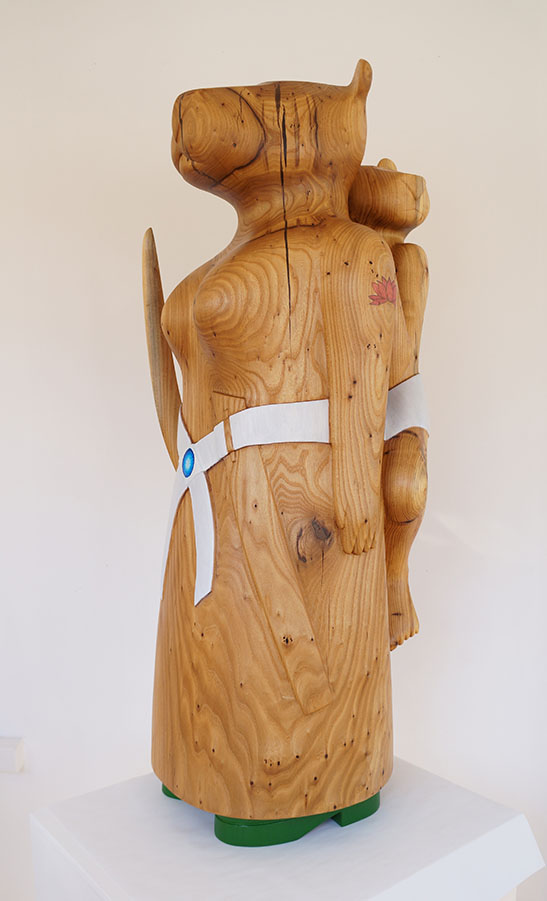
Donna Dodson, Lakshmibai: the Rani of Jhansi, 2021, chinese elm, enamel, colored pencils, acrylic, 39″ tall. One of the most striking sculptures in this new series represents a departure for Dodson. Her women sculptures are usually solitary. In Lakshmibai: the Rani of Jhansi, a young Bengal tiger cub is bound to his mother’s back. She stands strong, with a sword in her arm. The two aspects of the sculpture are striking, the warrior woman and the mother woman—both aspects necessary for survival.
Dodson has chosen to collaborate with animator Trina Baker, performance artist Kledia Spiro, and poet K. Melchor Hall, for their commitment to social justice. Their multi-media presentations on the walls surrounding Dodson’s central installation makes for a full immersion into a contemporary dialogue exploring the role of women. Dodson’s Amazons provide an inspiring catalyst for reflection.
—B. Amore
- Found Lineage: Celebrating African American Roots and Branches
The Black Heritage Trail • Portsmouth, NH • blackheritagetrailnh.org • Juneteenth Celebration June 17–19, 2021
In 2003, city workers discovered 13 coffins in downtown Portsmouth, NH. Further investigation found that these remains were all of African descent with as many as 200 people thought to be buried along the small area of Chestnut Street. That space, now designated as the African Burying Ground Memorial Park, has been host to many ceremonies and celebrations since its dedication in 2015. To celebrate Juneteenth, the Black Heritage Trail of New Hampshire will mark the holiday with Found Lineage: Celebrating African American Roots and Branches.
The three-day event commemorates the 19th of June, 1865, when the Union army reached more remote areas of Texas to enforce the Emancipation Proclamation that had been in effect since January 1, 1863. Juneteenth, the oldest nationally celebrated commemoration of the ending of slavery in the U.S., is recognized in all but four states. The Black Heritage Trail will offer workshops, a concert, and a keynote address with ancestor reverence drumming and dancing taking place at the African Burying Ground Memorial Park. The park includes historical information, granite seating walls, a community plaza, decorative tiles, landscaping, and two life-size sculptures designed by Jerome Meadows. The bronze cast represents a Portsmouth slave while the other represents Mother Africa.
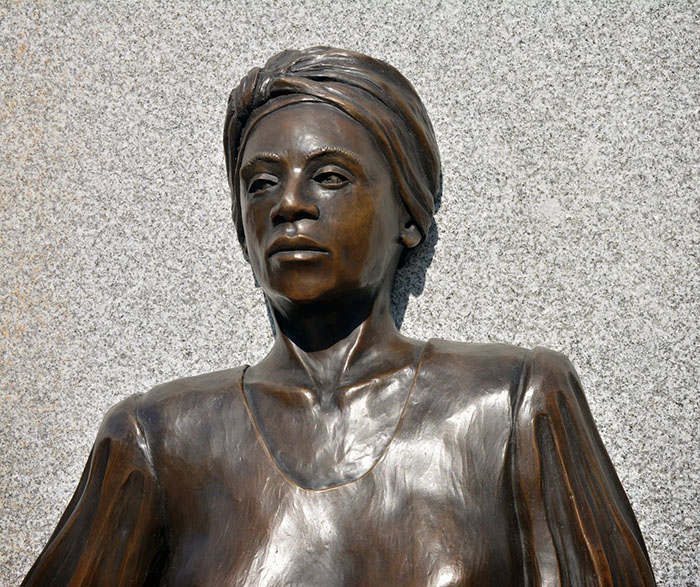
Jerome Meadows, Mother Africa, detail of bronze sculpture from African Burying Ground Memorial, 97 Chestnut Street, Portsmouth, NH. During this time, visitors may walk the many sites of the Black Heritage Trail. These designated landmarks apprise significant historical locations to the Black community of the area tracing back to the earliest enslavements in 1645. Notably, residences of enslaved people, houses of worship, and stops along the Underground Railroad make up the tour, including places associated with Ona Judge, Martha Washington’s famous fugitive slave. Visitors can receive free maps at the Black Heritage Trail office at 222 Court Street along with other literature for sale. The house is a historical marker with future plans of being a meeting place and expanded library. Guided walking tours are set to begin on Memorial Day weekend.
—Jennifer Mancuso
